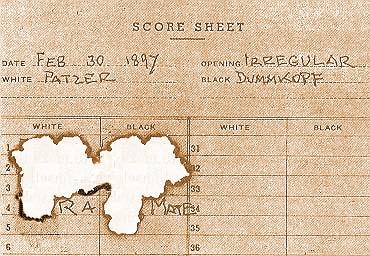
When contacting us by e-mail, correspondents are asked to include their name and full postal address and, when providing information, to quote exact book and magazine sources. The word ‘chess’ needs to appear in the subject-line or in the message itself.
| First column | << previous | Archives [18] | next >> | Current column |

The Patzer, who moved only one pawn, was so mortified by his quick defeat that he burned the score-sheet. Did he burn it enough to disguise how he was mated?
That stylish writer D.J. Morgan (1894-1978) was particularly interested in problems, but what is known about any compositions by him? The position below appeared in his Quotes & Queries column on page 487 of the December 1972 BCM:
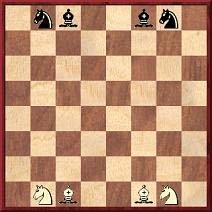
‘For the Quiet Half-hour. Put the knights and bishops on their home squares, as shown. Move one piece at a time, white and black alternately, so that the two colours shall exchange places, without any piece being attacked by, or attacking, another piece of opposite colour during the course of play. A knight can cross over to the king’s or the queen’s side. It can be done readily in 16 moves, but save a move and do it in 15.’
Was Morgan the composer? Such was explicitly stated on page 33 of The Book of Extraordinary Chess Problems by Stephen Addison (Ramsbury, 1989).
C.N. 4057 asked who was the first player to be recognized by FIDE as world champion, and in which year. The answer is Capablanca, in 1925.
Below is an excerpt from the report by Alexander Rueb, the FIDE President, to the Federation’s 1928 Congress in The Hague (page 4 of the Compte-Rendu):
‘A peine les derniers échos du grand congrès de Londres s’étaient tus qu’un nouvel événement échiquien d’une énorme importance s’est annoncé; sur l’initiative d’amis des échecs de l’Amérique du Sud de Buenos-Aires a eu lieu le match pour le championnat du monde.
Ce fait ne regardait la FIDE qu’en tant qu’elle avait reconnu officiellement à Zürich en 1925 M. Capablanca comme détenteur du titre. Pour le reste elle n’a joué aucun rôle dans l’arrangement de cette épreuve.’
On pages 11-14 of Chess Curiosities (London, 1985) Tim Krabbé discussed a ‘well-known trap’, one example being ‘Mattison – Millers, Karalauz [sic] 1926’:
1 e4 c5 2 g3 Nc6 3 Bg2 Nf6 4 Nc3 e6 5 f4 d5 6 e5 d4 7 exf6
dxc3 8 fxg7 cxd2+ 9 Qxd2 Bxg7 10 Bxc6+ bxc6 11 Qxd8+ Kxd8 12 c3
Rb8 13 Be3
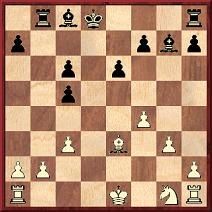
13...Rxb2 14 O–O–O+ Resigns.
His source was not indicated, but we note that the game was
published on page 76 of Šachs Latvijā by K. Bētiņš, A.
Kalniņš and V. Petrovs (Riga, 1940) as ‘H. Matisons – R.
Millers’ at ‘Karaļauči, 1926’ (i.e. that year’s tournament in
Königsberg, which was won by Leonhardt). On the other hand, the
corresponding crosstable on page 708 of volume 4 of Jeremy
Gaige’s Chess Tournament Crosstables (Philadelphia,
1974) lists an ‘H.G. Müller’ and a ‘Müller [of Tilsit]’ but no
Millers or Miller. Can anything more be discovered?
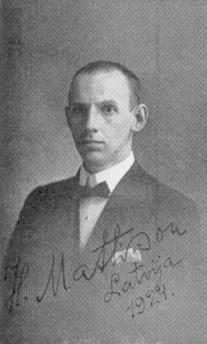
Herman Mattison (Hermanis Matisons)
Lesser-known examples of the ‘Thornton castling trap’ are on pages 61-63 of Kings, Commoners and Knaves. We proposed that term because the oldest known specimen is G.H. Thornton v Boultbee, published on page 31 of the 15 November 1884 Brooklyn Chess Chronicle.
A strange matter from two decades ago (C.N. 1181 – see page 96 of Chess Explorations) is revived here.
One of Alekhine’s most notable sacrificial experiments was in the sixth game of his 1937 world championship match against Euwe. As White he opened 1 d4 d5 2 c4 c6 3 Nc3 dxc4 4 e4 e5 5 Bxc4 exd4 6 Nf3 and won quickly after Euwe’s 6...b5? In his notes (My Best Games) Alekhine said that his ‘chief’ variation started 6...dxc3 7 Bxf7+ Ke7 8 Qb3 Nf6, etc., which contradicts Reinfeld’s claim (The Human Side of Chess, page 211) that the ‘greatest gamble of his life’ was played ‘on the spur of the moment’.
It always seems to have been assumed that Alekhine was the first to play this piece sacrifice, but we found the following game, recorded as having been played 13 years earlier, in 120 Partidas Cortas de Ajedrez by Gumersindo Martínez (Havana, 1947), page 74:
J.F. Migoya – N.N.1 d4 d5 2 c4 c6 3 Nc3 dxc4 4 e4 e5 5 Nf3 exd4
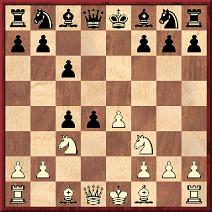
6 Bxc4 dxc3 7 Bxf7+ Ke7 8 Qb3 Nf6 9 O-O Na6 10 Bg5 h6 11 Bh4 g5 12 Nxg5 hxg5 13 Bxg5 Bg7 14 e5 Rf8 15 exf6+ Bxf6 16 Rfe1+ Kd6 17 Rad1+ Kc7 18 Bf4+ Resigns.
Can any further particulars be found?
Another old matter (see pages 23-24 of Chess Explorations) concerns the position below, which C.N. 1670 gleaned from page 17 of the June 1988 issue of Europa-Rochade:
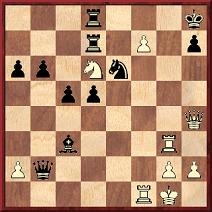
Capablanca was stated by the German magazine to have had White against an unidentified opponent in an unidentified simultaneous display, and to have won as follows:
1 Qxd8+ Rxd8 2 f8(Q)+ Rxf8 3 Rxf8+ Nxf8 4 Nf7 mate.
Is anything more known about this game?
Michael McDowell (Westcliff-on-sea, England) points out that the obituary of D.J. Morgan by G.W. Chandler on page 246 of The Problemist, September 1978 specifically stated that ‘he was not a composer’.
Our next batch will contain a brief feature on a famous figure who wrote (once only?) about chess.
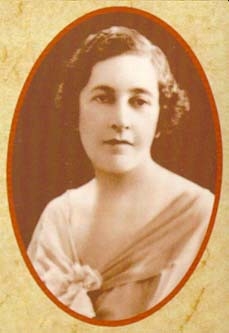
The writer referred to in C.N. 4082 was Agatha Christie (1890-1976). Her 1927 book The Big Four included ‘A Chess Problem’, which mentioned Lasker, Capablanca and Rubinstein. A murder mystery solved by Hercule Poirot, it has often been anthologized as a short story, two instances in the chess world being pages 184-195 of Chess in Literature by Marcello Trutti (New York, 1974) and pages 222-233 of Sinister Gambits by Richard Peyton (London, 1991).
Did Agatha Christie refer to chess anywhere else in her writings?
The solution will be given shortly, but for now we help a little by showing the Patzer’s game-score when it was less burnt:
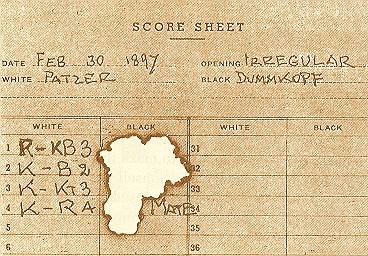
Over the next few weeks a number of older items on unresolved
matters will be presented again. Here, firstly, we mention that
information is still being sought on two women players of the
1930s (see page 305 of Kings, Commoners and Knaves).
The first is Maud Flandin. Pages 928-929 of the January-February 1935 L’Echiquier gave two positions from games won by her, with the following text:
‘La championne de France, Mlle Maud Flandin (née a Saïgon) a très vite atteint un haut degré de perfection. Elle va probablement affronter en 1935 la détentrice du titre mondial, Mlle Vera Menchik.’
She never did compete for the women’s world championship, but what can be found out about her?
The other case is even stranger, involving an extravagant claim. In the early 1990s David Pritchard sent us a page from one of his scrapbooks which had an item published in the Daily Sketch in 1936 (exact date not recorded):
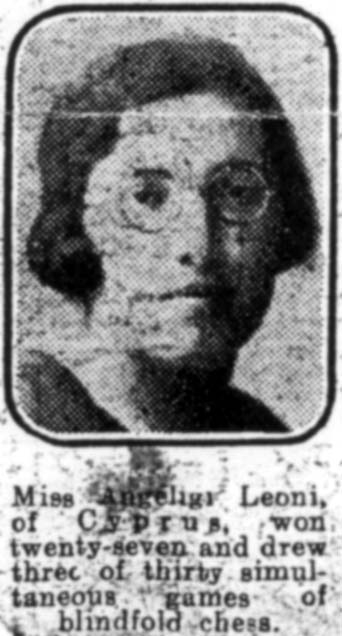
‘Miss Angeligi Leoni, of Cyprus, won twenty-seven and drew three of thirty simultaneous games of blindfold chess.’
In C.N. 3988 a correspondent wrote that the author of the 1945 book Mis Cincuenta Partidas con Maestros was Manuel de Agustín and not Arturo Pomar. Now Miquel Artigas (Sabadell, Spain) informs us that he has acquired a copy which de Agustín inscribed, referring to himself as ‘el autor’:
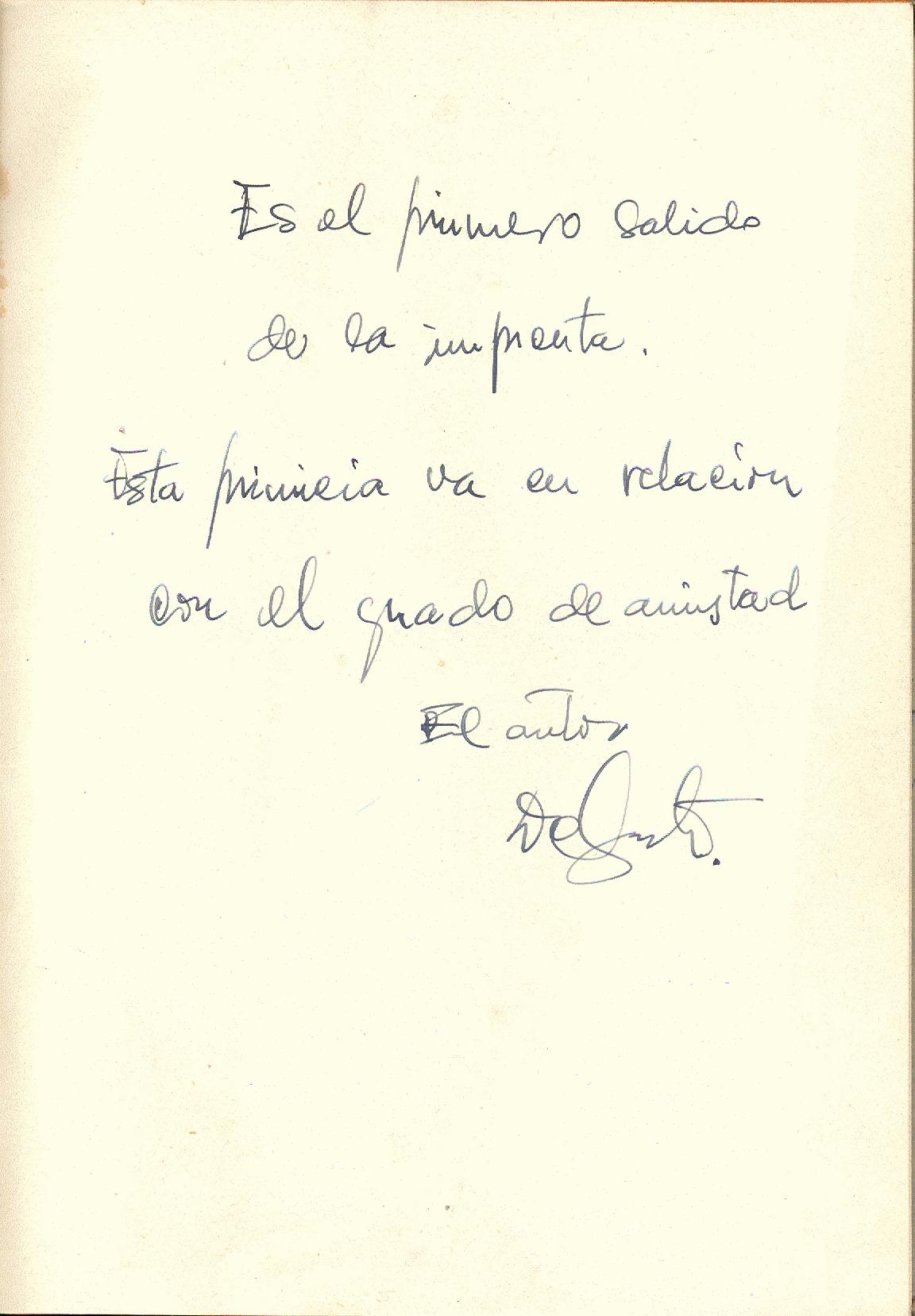
‘Es el primero salido de la imprenta. Esta primicia va en relación con el grado de amistad. El autor, De Agustín.’
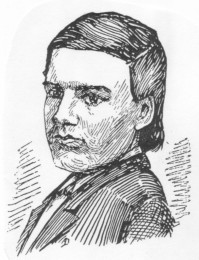
James A. Leonard
McFarland & Company has just published an excellent book by John Hilbert, The Tragic Life and Short Chess Career of James A. Leonard, 1841-1862. In addition to a detailed biography, over 90 of Leonard’s games are presented, and here we select two, the first being a rare nineteenth-century instance of a pawn storm by each player:
James A. Leonard – William G. Thomas1 e4 e5 2 Nf3 d6 3 d4 exd4 4 Qxd4 Nf6 5 Nc3 Be7 6 Be3 O-O 7 O-O-O Nc6 8 Qd2 Bd7 9 Bd3 a6 10 h3 b5 11 Nd5 Nxd5 12 exd5 Ne5 13 Nxe5 dxe5 14 f4 Bd6 15 f5 Qe7 16 g4 f6 17 h4 a5 18 g5 a4 19 h5 b4
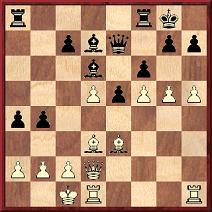
20 h6 Rfb8 21 hxg7 b3 22 a3 Bxa3 23 c4 Bxb2+ 24 Qxb2 a3 25 Qh2 Qxg7 26 gxf6 Qf7 27 Rdg1+ Kh8 28 Rg7 b2+ 29 Kd2
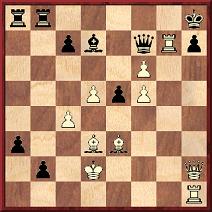
29...b1(N)+ 30 Bxb1 Rb2+ 31 Bc2 Rxc2+ 32 Kxc2 Bxf5+ 33 Kc3 Qxf6 34 Qxh7+ Bxh7 35 Rhxh7 mate.
The second game has an unusual sacrificial motif at move 24:
James A. Leonard – Thomas Loyd1 e4 e5 2 Nf3 Nc6 3 Bc4 Bc5 4 b4 Bxb4 5 c3 Ba5 6 d4 exd4 7 O-O Nge7 8 cxd4 d5 9 exd5 Nxd5 10 Ng5 O-O 11 Nxh7 Kxh7 12 Qh5+ Kg8 13 Bxd5 Bb6 14 Nc3 Nxd4 15 Bg5 Qd6 16 Qh4 Ne2+ 17 Nxe2 Qxd5 18 Rad1 Qe5 19 Nf4 f6 20 Ng6 Qe8 21 Qh8+ Kf7 22 Qh5 fxg5 23 Nxf8+ Kxf8
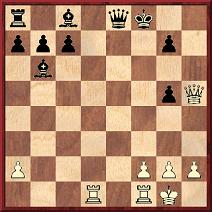
24 Rd8 Qxd8 25 Qh8+ Ke7 26 Qxg7+ Ke6 27 Re1+ Kf5 28 Qf7+ Kg4 29 Qf3+ (29 Re4 mate.) 29...Kh4 30 g3+ Kh3 31 Qh5 mate.
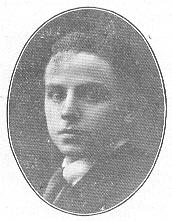
Who is this?
From Richard Forster (Winterthur, Switzerland) and Tomasz Lissowski (Warsaw):
‘Sergei Voronkov discussed Tartakower’s poetic achievements in an article on pages 45-47 of the 3/1998 Shakhmatny v Rossii. He also referred to another article on Tartakower by Yuri Arkhipov in 64 – Shakhmatnoe Obozrenie, 5/1987, pages 24-26.
In 1911 Tartakower had a 56-page booklet Neskol’ko stikhotvorenii (“A few poems”) published in the edition “Nauka i zhizn’” in Rostov-on-Don. It consisted of two parts: “Dissonansy” (22 eight-line compositions) and “Accordy” (13 longer poems). The well-known critic Nikolai Gumilev reviewed it in the literary magazine Apollon (No. 10, 1911; the review was subsequently reprinted in Gumilev’s “articles and notes on Russian poetry”). He found that Tartakower was a true poet, with focussed thoughts and great inner experience. On the other hand, he noted: “But he has no feeling for the Russian language; worse still, he does not know it! His syntax is impossible, his vocabulary preposterous.” Gumilev concluded that Tartakower would do better to write his poems in Yiddish, “and then his poems would be much more interesting to read in translation”.
Voronkov further showed that, contrary to what most (Western) sources state, the pogrom in which Tartakower’s parents were killed occurred not in 1899 but in 1911 (although the infamous and best-known Jewish pogroms in Rostov took place in 1905). Tartakower refers to this in one of his own poems (our translation):
One More, The Final Dissonance
(on the death of the parents)
A whole century of surrenders, tears, and strains.
And for whom? For children, who live safe
In foreign lands. If you ask them:
“Easy life, eh, old men?”, “Yes” – they answer.
Returning home in the early morning
I took and opened the telegram: “Your parents killed.”
I hurried. I buried. The iron plates
of two bloody graves lie on my heart.The fact that Tartakower’s poems were published in Rostov in 1911 suggests that despite attending a college in Geneva and spending much of the first decade of the twentieth century in Vienna, he was still maintaining ties with his native city at that time.
Tartakower translated numerous Russian poems into French and German for various journals. In 1922 and 1923 he had two anthologies published in Berlin with poems which he had translated into Russian. Another one (Das russische Revolutionsgesicht, published around 1923) was devoted to contemporary Russian poetry translated into German. In later years, when publishing poems of his own Tartakower assumed the name “Rewokatrat” , i.e. Tartakower in reverse.With his obscure Russian brochure Antologiya lunnykh poetov (“Anthology of lunar poets”) “Rewokatrat” even attracted the attention of Vladimir Nabokov. The great writer’s final verdict, however, was quite devastating: “Write, but do not think it is poetry.” (Review in the Russian-language paper Rul’ (Berlin), 6 June 1928. See also Nabokov’s collected Russian-language works in five volumes, St Petersburg 1999-2000, volume 2, pages 660-661.)
Voronkov’s article gave a number of Tartakower’s poems from 1911 and discussed his whereabouts during the First World War. He also mentioned Tartakower’s brother Artur (cf. C.N. 3946), who was one year his junior and also a law student at Vienna University. He died on 19 November 1914 on the battle-ground near Katowice (in Silesia, then a part of the German Empire and nowadays in Southern Poland).’
C.N. 1323 gave the following game between R. Dzindzichashvili and Y. Zacharov, which the winner concluded by successively retreating three pieces to their home squares:
1 e4 c5 2 c3 Nf6 3 e5 Nd5 4 d4 cxd4 5 cxd4 d6 6 Nf3 Nc6 7 Be2 Bf5 8 O-O dxe5 9 dxe5 e6 10 Bd2 Ndb4 11 Nc3 Nd3 12 Bg5 Nxb2 13 Qxd8+ Nxd8 14 Bb5+ Nc6 15 Nd4 Bd3 16 Nxc6 Bxf1
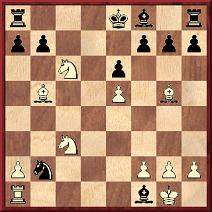
17 Bxf1 bxc6 18 Bc1 Ba3 19 Nb1 Resigns.
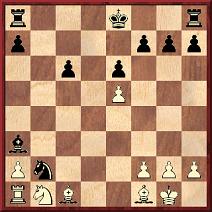
We took the game from pages 8-9 of Roman Dzindzichashvili –
Sein Aufstieg zur Weltspitze by Manfred van Fondern
(Hollfeld, 1982), which stated that it was played in the 1957
Soviet Junior Championship. However, page 258 of Chess
Explorations reported that no such championship had been
traced and that Bob Wade’s suggestion was that the game had
probably occurred in the 1957 Soviet Junior Team Championship in
Vladimir (in which both Dzindzichashvili and Zacharov
participated). Can readers shed any further light? As regards the
conclusion itself, Black’s resignation now looks rather premature.
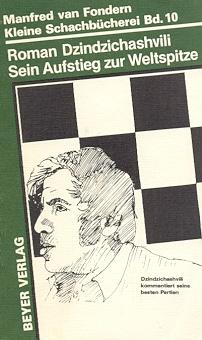
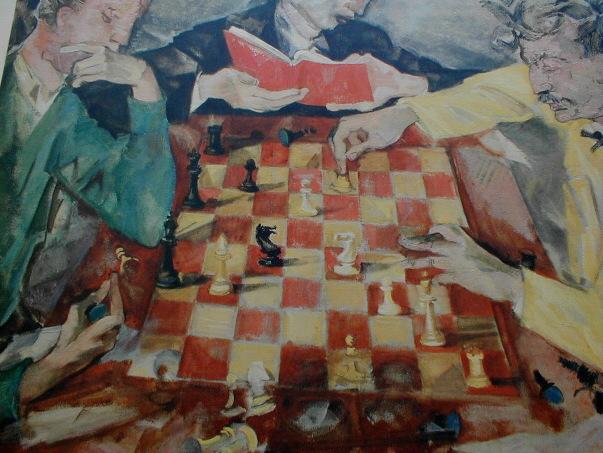
Mark N. Taylor (Mt Berry, GA, USA) sends the above picture and observes:
‘This is Maximilian Mopp’s “Chess with Emanuel Lasker”, of which I have a print (“Copyright 1953. Arthur Rothmann Fine Arts, Inc., N. Y. C.” ). Can anyone identify the position on the board, Lasker’s opponent, or the third figure? Mopp is perhaps best known to chessplayers as the illustrator of Edward Lasker’s Chess for Fun & Chess for Blood.’
What is the quickest win for White in this position?
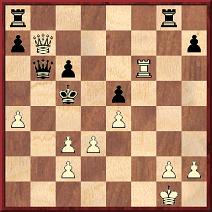
The answer, of course, is not 1 Rxc6+ Qxc6 2 Qb4 mate, a mating pattern famous from the 1933 game of living chess between Capablanca and Herman Steiner in Los Angeles, which featured a similar, but not identical, position. For details see pages 225-226 of Kings, Commoners and Knaves, which included an earlier game with the 1 Rxc6+ Qxc6 2 Qb4 mate finish (Tartakower v Holte, Copenhagen, 1923).
Our book also quoted Steiner’s comment on page 66 of the March 1943 Chess Review that the Los Angeles game was ‘pre-arranged by Capablanca’, and we are aware of no counter-evidence.
Below is a picture of the occasion, from page 132 of MD en español, September 1973:
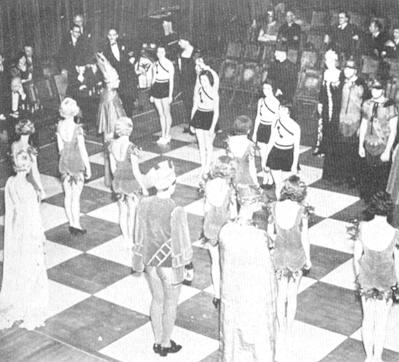
It is also worth noting the following shot, from page 31 of Famous Chess Players by Peter Morris Lerner (Minneapolis, 1973):
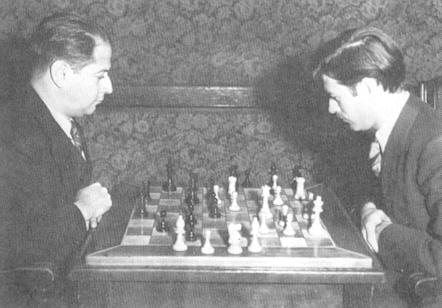
‘José Capablanca (left) meets with US chess master Herman Steiner (right) for an informal game of chess in Los Angeles, 1933.’
A few jottings are offered now on some other games of living chess involving Capablanca. The earliest photograph we have found was included at the end of volume one of Miguel A. Sánchez’s monograph Capablanca, Leyenda y Realidad (Havana, 1978):
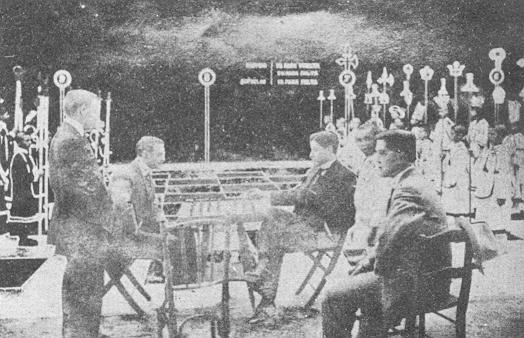
‘Se enfrentan Capablanca y Corzo. La partida se reproduce con figuras vivientes. 1912’
However, it was not until Capablanca had lost his world championship title that he became relatively active in living chess. The next photograph shows him with Sir George Thomas at Ramsgate in 1929.
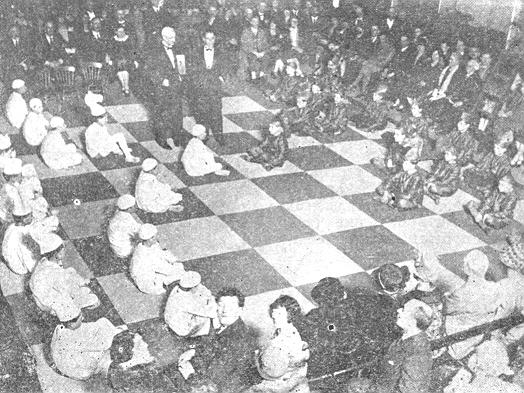
‘Fifty Ramsgate schoolboys, all chessplayers, represented the pieces, and players were mounted on ladders – the type used by tennis umpires’, was the description on page 102 of the May-June 1929 American Chess Bulletin, which also reported on another such spectacle:
‘A “living chess” display was given in the Great Hall of the Regentenbau on 19 August. It was said to be the best ever given. Kissingen made it practically a city function. The “pieces” wore old Bavarian costumes, and their movements were directed by the court jester. The chess side of it was naturally arranged for spectacular purposes. Dr S. Tarrasch played a “skittle” game against E.D. Bogoljubow, and then J.R. Capablanca took the black forces against F.J. Marshall, this game ending in a draw by perpetual check, the white queen making the necessary moves to that end.’
More information about that occasion will be welcomed.
The following year Capablanca played twice against Rudolf Elstner at the Lunapark, Berlin. Both games were prematurely broken off but were given in a brief news item on pages 236-237 of the August 1930 Deutsche Schachzeitung:
José Raúl Capablanca – Rudolf Elstner1 e4 e5 2 Nf3 Nc6 3 Bb5 a6 4 Ba4 d6 5 c3 f5 6 exf5 Bxf5 7 d4 e4 8 d5 exf3 9 dxc6 b5 10 Qxf3 Bxb1 11 Bb3 Bg6 12 O-O Be7 13 Re1 Nf6 14 Bg5 Rf8 15 Qh3.
Rudolf Elstner – José Raúl Capablanca1 e4 e6 2 d4 d5 3 Nc3 Bb4 4 Bd3 c5 5 exd5 Qxd5 6 Kf1 Bxc3 7 bxc3 Nf6 8 Qf3 c4 9 Be2 O-O 10 Ba3 Re8 11 Nh3 Qxf3 12 Bxf3 Nd5 13 Bxd5 exd5 14 Nf4 Be6 15 Re1 Nd7 16 f3 Nf6 17 Kf2.
Below are two photographs of Capablanca in Berlin:
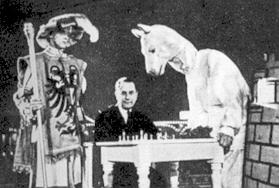
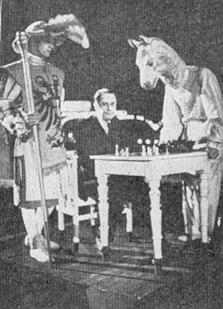
The scores of the above-mentioned games against Thomas and Steiner can be found on pages 114-115 of The Unknown Capablanca by David Hooper and Dale Brandreth (London, 1975). As regards moving pictures of the Cuban and Sir George Thomas playing living chess (in 1936), readers are referred to the Pathé link in C.N. 3491.

C.N. 4075 asked whether the Patzer, who had moved only one pawn and was mortified by his quick defeat, had burned his score-sheet enough to disguise how he was mated. The answer is yes.
From the second (‘less burnt’) version given in C.N. 4084 ...

... it can be ascertained that the game went 1 f3 e6 (or e5) 2 Kf2 Qf6 3 Kg3 Qxf3+ 4 Kh4 Be7 mate. However, with the two burns there are also such possibilities as 1 Nc3 e6 (or e5) 2 Na4 Bc5 3 Nb6 Qf6 4 h4 Qxf2 (or Bxf2) mate and (as pointed out by Wijnand Engelkes, Zeist, the Netherlands) 1 Nc3 e6 (or e5) 2 Rb1 Qf6 3 a3 Bc5 4 Na4 Qxf2 (Bxf2) mate.
The first illustration above is our own concoction from the second one, the latter having been published on pages 347-348 of The Colossal Book of Short Puzzles and Problems by Martin Gardner (New York, 2006). The task in the book was to reconstruct the game. No source for the problem was given, except that its contributor, Randolph W. Banner, ‘thinks he saw it in an English periodical published about 1920’.
We have yet to look into that suggestion, although it may be recalled that a fatal king dash featured in the solution to a famous Sam Loyd puzzle: ‘Find how discovered checkmate can be effected in four moves.’ See page 58 of Sam Loyd and His Chess Problems (Leeds, 1913).
Martin Gardner’s book has a chapter on chess problems (pages 339-364), most of them quite well known.
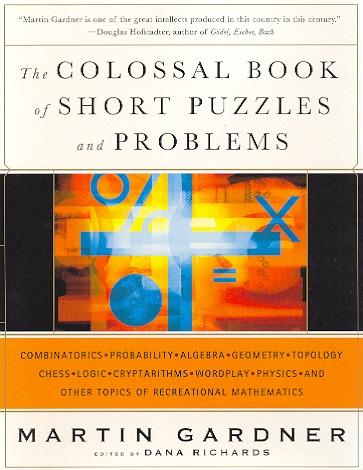
John Donaldson (Berkeley, CA, USA) writes:
‘There is a mystery concerning Imre König’s famous win over H. Weiss (1 d4 e6 2 c3 d5 3 Bf4 Nf6 4 e3 c5 5 Bd3 Nc6 6 Nd2 Be7 7 Ngf3 O-O 8 Ne5 Re8 9 g4 Nxe5 10 dxe5 Nd7 11 g5 Nf8 12 h4 Bd7 13 Qg4 Bc6 14 O-O-O b5 15 h5 c4 16 Bxh7+ Nxh7 17 g6 Ng5 18 Ne4 Nxe4 19 gxf7+ Kxf7 20 Qg6+ Kf8 21 h6 Bf6 22 hxg7+ Bxg7 23 Rh8+ Bxh8 24 Bh6+ Ke7 25 Qh7+ and mate next move). The game was published in The Art of Attack in Chess by V. Vuković (on pages 246-248 of the first edition and pages 218-220 of the second) and was König’s personal selection for his representative game on pages 130-133 of British Chess (Oxford, 1983). He stated there that he was born in 1901 and that “my first real step in chess occurred when at the age of 19 I had gone to study in Vienna”. The game, reproduced from Vuković’s book, was headed “Vienna, 1919”. In what event did it occur?’
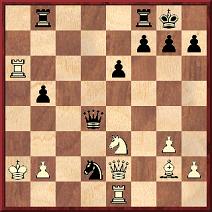
25...Qb6 26 Ra3 b4 27 Ra4 Qd4 28 Ka1 Rfc8 29 Rd1 b3 30 Ra3 Rc2 31 White resigns.
The earlier C.N. items indicated that this occurred in the game between Delfino Gastaldi and Angelo Giusti in the sixth Italian correspondence championship, 1953-54. Now Stefano Ticozzi (Galliate, Italy) comments that the game is available (with notes by Giorgio Porreca from L’Italia Scacchistica, February 1955, pages 41-42) at an Italian website, together with information about Giusti. He also draws attention to a biographical note about, and photograph of, Gastaldi.
‘I believe that this book is the first in the history of chess literature to be made up exclusively of amateurs’ games ...’
Fred Reinfeld on page ix of his book Chess for Amateurs (Philadelphia and London, 1943).
From Brian Karen (Levittown, NY, USA):
‘I asked Roman Dzindzichashvili about C.N. 4090 in a telephone conversation on 12 January 2006, and he confirmed that the game was played in the 1957 Soviet Junior Team Championship. He also mentioned that Black did not resign in the final position given. However, that was all that he reconstructed of the game at the time.’
As noted in C.N. 1526, page 253 of the June 1895 BCM mentioned a new chess column in the Lady’s Pictorial, ‘edited by Mrs Gunsberg’. Moreover, page 26 of the January 1903 BCM had a reference to a solving tournament won by ‘a young son of Mr Gunsberg’ (see C.N. 3751).
Further information on these family members is still being sought, and we add here the following (unsigned) passage from page 128 of the April 1890 BCM:
‘Mr Gunsberg has had a severe domestic affliction since his return from Havana, as he has lost a child. He tells me that he has no doubt that his match with Steinitz will take place in the autumn.’
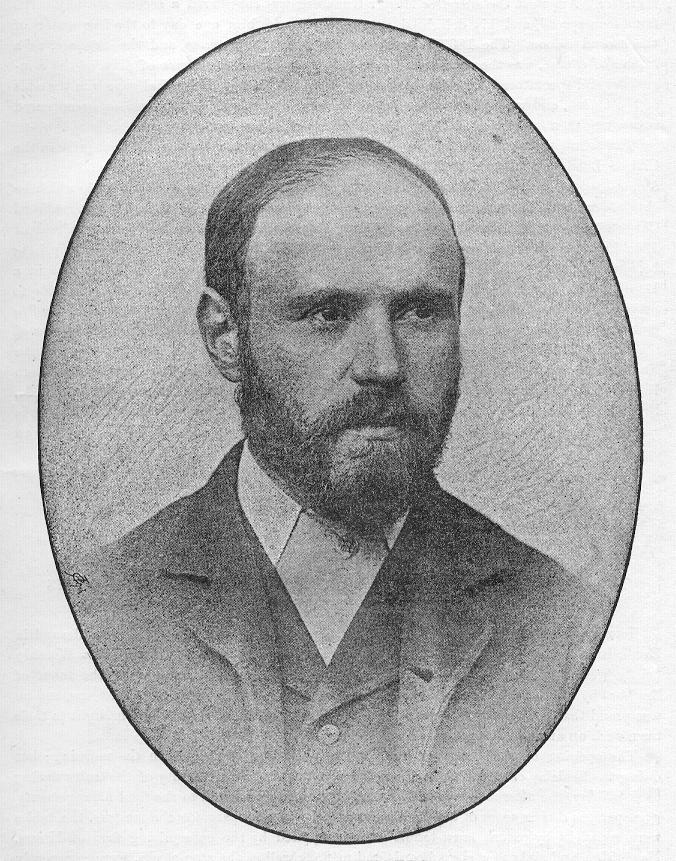
Isidor Arthur Gunsberg
Pablo S. Domínguez (Madrid) writes:
‘I have found a reference to the Combe v Hasenfuss game in 100 Soviet Chess Miniatures by P.H. Clarke (London, 1963). Pages 59-60 gave the game Klachko v Chembrovsky, Leningrad, 1957, which began 1 d4 c5 2 e4 cxd4 3 Nf3 e5 4 c3, at which point Clarke wrote:
“But not 4 Nxe5 Qa5+ 5 White resigns, which was what happened in the game Combe – Hasenfuss, International Team Tournament, Folkestone, 1933. I wonder whether the Scottish player would have been so generous if he had known that when this trap occurred in a game between the Russian masters Shumov and Jaenisch more than 70 years before, White had not only carried on but even won.”’
Our correspondent points out that the earlier game was in fact played at the beginning of the 1850s. It was published on pages 289-290 of the 1851 Chess Player’s Chronicle:
Ilia Shumov – Carl Friedrich von Jaenisch
St Petersburg, circa 1851
Sicilian Defence
1 e4 c5 2 d4 cxd4 3 Nf3 e5 4 Nxe5 (The Chronicle commented: ‘By this hasty slip White loses a piece at the very outset of the play; a loss, however, which is hardly to be deplored, since it gives rise to an attack on his part more brilliant and spirited than we often see in modern days.’) 4...Qa5+ 5 b4 Bxb4+ 6 Bd2 Bxd2+ 7 Nxd2 Qxe5 8 Bd3 Nf6 9 O-O O-O 10 f4 Qc5 11 e5 Nd5 12 Bxh7+ Kxh7 13 Qh5+ Kg8 14 Ne4 Qxc2 15 Rae1 Ne3 16 Rxe3 dxe3 17 Qf5 Qe2 18 Nf6+ gxf6 19 exf6 Qc2 20 Qxc2 d5 21 Qd3 d4 22 Qb5 Rd8 23 Rf3 Bf5 24 Qxf5 Nc6 25 Qc5 Resigns.
From Mark N. Taylor (Mt Berry, GA, USA):
‘It is not difficult to find instances of prolific chess hacks contradicting themselves in print, but how about highly-respected authors? I offer the following from Francis Bacon’s Essays (1601):
- “[A] gamester seeth always more than a looker-on ....” (“Of Friendship”)
- “Lookers-on many times see more than gamesters ...” (“Of Followers And Friends”)’
When did Capablanca first acquire the nickname ‘The Chess Machine’? It is difficult, if not impossible, to say, but we can offer the following quotation from page 98 of the May-June 1921 American Chess Bulletin:
‘Capablanca is a veritable chess machine, if ever there was one. Ajeeb, were he in power today, would have to take a back seat, and way back, too. Only a machine could have done with Lasker what the Cuban did at Havana ...’
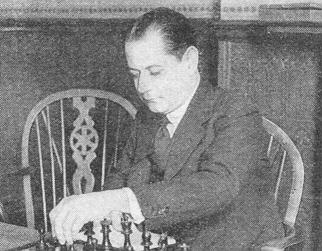
José Raúl Capablanca
Dominique Thimognier (St Cyr sur Loire, France) sends us an extract from page 2 of the Bulletin de la FFE, April-July 1934, which contained an account of the 1933-34 women’s championship of France. This stated that Maud Flandin finished second but was declared champion because the first-placed player, named Tonini, was Italian. The following game was given:
Jacobson – Maud Flandin1 d4 d5 2 e3 c6 3 c4 e6 4 Nf3 Bd6 5 Bd3 Nf6 6 O-O Nbd7 7 Re1 O-O 8 Nc3 Re8 9 e4 dxe4 10 Nxe4 Nxe4 11 Bxe4 Nf6 12 Bd3 h6 13 Ne5 Qc7 14 c5 Be7 15 b4 Rd8 16 Be3 b6 17 f4 Nd5 18 Qh5 Bf6 19 Be4 Bxe5 20 fxe5 Nxe3 21 Rxe3 Rxd4 22 a3 bxc5 23 bxc5 Rc4 24 Re2 Rxc5 25 Rf1 f5 26 Qe8+ Kh7 27 Bb1 Rxe5 28 Rxe5 Qxe5 29 Qxc6 Rb8 30 Qa4 Qe3+ 31 Kh1 Rb2 32 Qd1 Bb7 33 Rg1 Qf2 34 Qf1 Qxf1 35 Rxf1 Bxg2+ 36 Kg1 Bxf1 37 White resigns.
Our correspondent also draws attention to page 3 of the June 1935 issue of L’Echo des Echecs, which reported that Maud Flandin participated in the next French championship, which began on 30 May 1935. Other contestants included Grace Alekhine. The magazine stated that the winner would be designated as a participant in the women’s world championship in Warsaw later that year (although it turned out that the tournament in Poland had no representative of France).
The July 1935 issue of L’Echo des Echecs (page 2) related that Maud Flandin was again second, behind Mlle P. Schwarzmann. As the full results were not given, regarding Grace Alekhine it can only be said that she finished outside the top four.
After that, our correspondent’s trail on Maud Flandin goes cold, although he is able to point out a report on page 7 of the November 1944 Bulletin de la FFE that Grace Alekhine was the women’s champion of Paris in 1944:
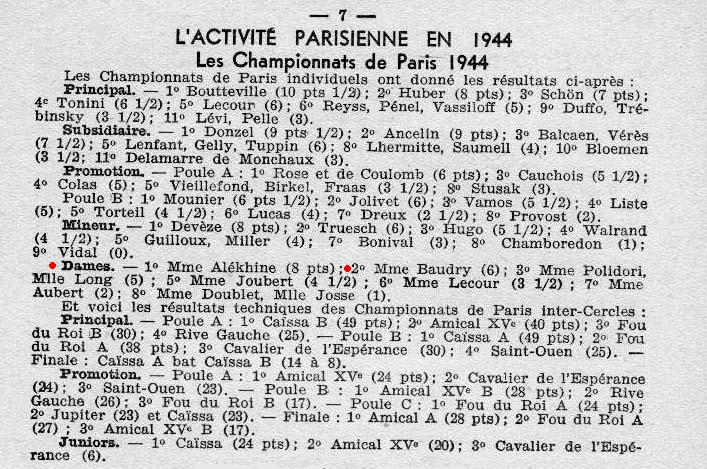
Various C.N. items (for details, see the Factfinder) have presented photographs of the graves of chess figures, including Capablanca and Alekhine. Now José Angulo (Barcelona, Spain) asks about the graves of Lasker and Euwe.
With regard to Euwe, we are hopeful that a Dutch reader can provide full particulars. Concerning Lasker we have no photograph but can outline the facts.
Emanuel Lasker died at Mount Sinai Hospital, New York shortly before midday on 11 January 1941 (the erroneous date 13 January is sometimes seen even today); he had been in the hospital for two weeks. This information comes from page 1 of the January-February 1941 American Chess Bulletin, which also reported:
‘Many sorrowing friends and admirers gathered on Monday, 13 January at the Riverside Memorial Chapel, to attend the funeral services conducted by the Rev. Dr David de Sola Pool, rabbi of the Spanish and Portuguese Synagogue, Shearith Island, a personal friend of Dr Lasker’s and a member of his chess class. That afternoon, interment took place at the Shearith Israel Cemetery in Cypress Hills on Long Island.’
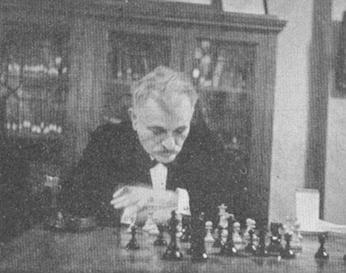
Emanuel Lasker
The following books about Pillsbury are in our collection. Do any others exist?
No further information has yet come to light, but we note that when The Big Four was brought out by Planet Three Publishing Network Ltd. (no date given) the front cover had a chess illustration:
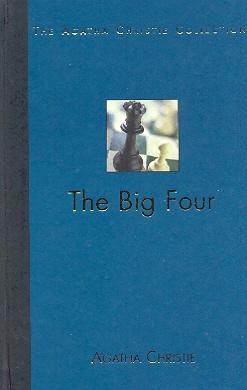
W.D. Rubinstein (Aberystwyth, Wales) recalls a story by or about Al Horowitz that after he made a good move in a simultaneous exhibition his opponent dropped dead. He asks what more is known about this.
In a short item on pages 78-79 of All About Chess (New York, 1971) Al Horowitz wrote:
‘If any game is to be dubbed the “Immortal Zwischenzug”, it is this one, played in the great tournament of New York in 1924.’
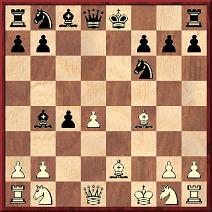
After Tartakower’s 9 Bxb8 Capablanca played his famous move 9...Nd5.
‘Copying’ in the heading is to be taken euphemistically, for
the theme here is plagiarism and piracy by Dimitrije Bjelica. In
addition to what he did to Christiaan Bijl’s anthology of
Fischer’s games (see pages 8-9 of the 5/1986 New in Chess and
pages 278-279 of Kings, Commoners and Knaves) there is
his misappropriation of extensive material from Irving Chernev’s
1974 book Wonders and Curiosities of Chess for his
cut-and-paste volume Wonderful world of chess (C.N.
3260).
Here, for example, is page 62 of the Chernev book:
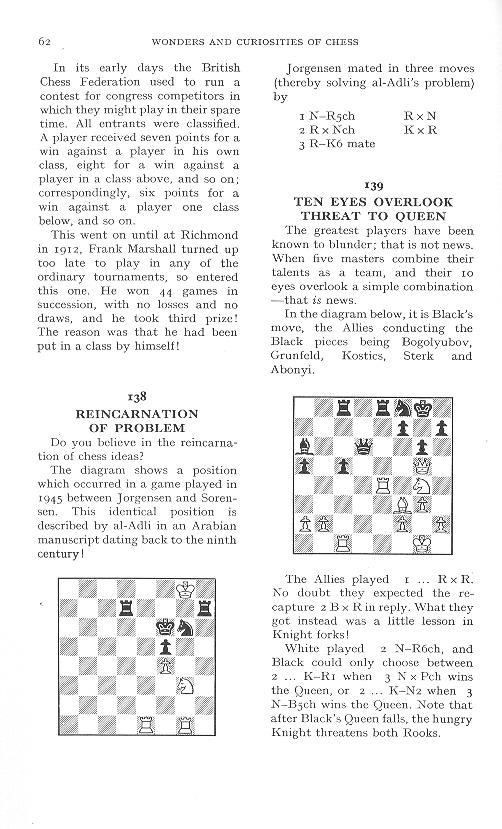
Enter Dimitrije Bjelica, armed with scissors, glue and photocopier, but no ethics. The result is the following, on pages 97 and 115 of his book:
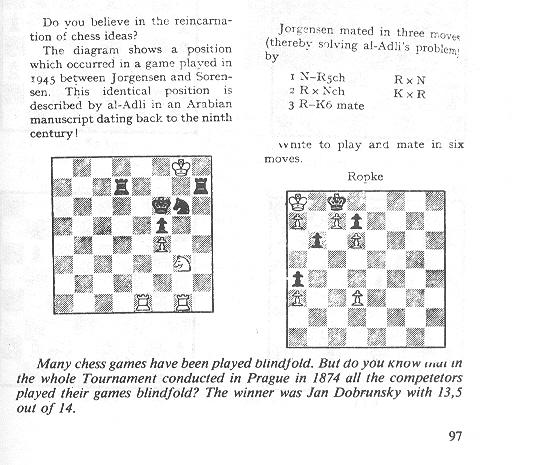
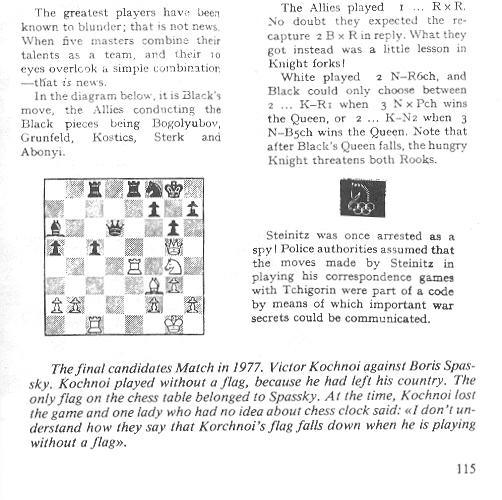
These are not isolated instances. Bjelica
(whose role as Director of the so-called ‘International Chess
Writers Association’ is referred to in our Chess Awards article) did the same
thing with Chernev’s work (still without crediting him, of course)
on pages 33, 53, 55, 79, 103, 105, 109 and 111.
Hassan Roger Sadeghi (Lausanne, Switzerland) provides a link to some information about the grave of Emanuel Lasker.
One of the worst chess books ever published is the subject of our latest feature article to be posted.
With regard to the quote in C.N. 4062, Christian Sánchez (Rosario, Argentina) points out that Daniel J. Greenway did indeed have an entry in Jeremy Gaige’s Chess Personalia (page 149).
Readers are invited to inform us of any elegant or interesting bookplates with a chess theme. One we particularly like is the late James J. Barrett’s:
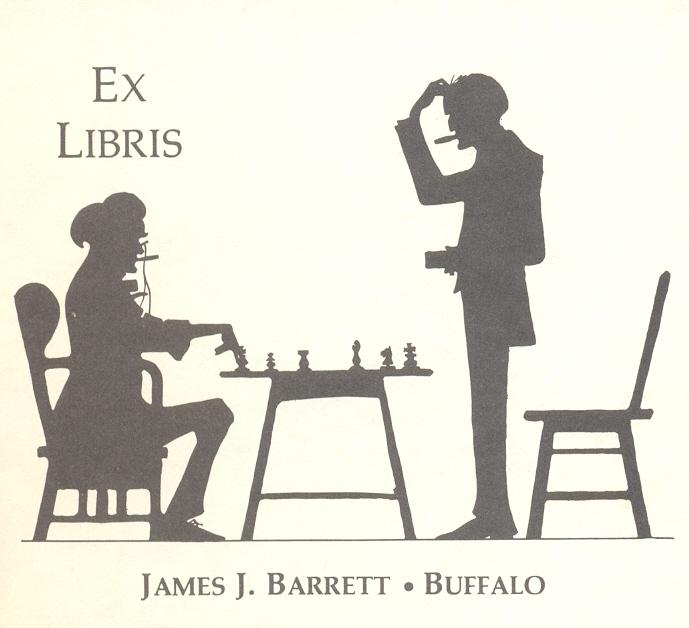
Which chess masters have been depicted in silhouette form? At present we can think of only one, Capablanca. Below is the front cover of the Russian edition of his autobiography My Chess Career (Leningrad, 1924):
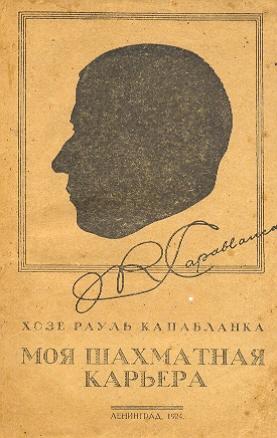
What is the earliest known sighting of the well-known story about Capablanca turning up in his tennis gear to resume a game of chess against Yates at Hastings? See, for instance, pages 16-17 of The Bright Side of Chess by I. Chernev (Philadelphia, 1948).
We open the bidding with the following ‘once’ version by G. Koltanowski on page 180 of CHESS, 14 January 1936:
‘Capablanca once turned up to play off an adjourned game against Yates, dressed in white flannels and with a tennis racquet in his hand. Didn’t we chuckle when, four hours later, with the darkness of night outside the congress room, he was still playing – chess, not tennis.’
Koltanowski wrote similarly on page 80 of With the Chess Masters (San Francisco, 1972), but on page 24 of Chessnicdotes II (Coraopolis, 1981) he underscored once again his worthlessness as a chronicler by stating that the episode had occurred ‘in the 1929 tournament at Hastings’ in a game between Capablanca and Vera Menchik.
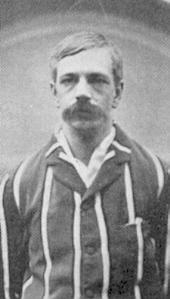
Sir George Thomas
Sir George Thomas’ prowess at tennis is less well-known than his achievements at chess and badminton. In C.N. 1677 Tim Krabbé asked about his exact results at Wimbledon, and C.N. 1693 presented a complete list, courtesy of Stewart Reuben (who received it from the Honorary Librarian of the Wimbledon Lawn Tennis Museum):
Addition on 21 July 2023:
Andrea Aliferopulos (Gytheio, Greece) notes that there is now a Wimbledon webpage which gives a more extensive record. It shows that for the period (1919-26) covered in our item C.N. 1693, reproduced above, one result is missing: Sir George Thomas’s loss in Round I of the Gentlemen’s Doubles in 1924. However, the website records that he also participated in competitions from 1906 to 1914, with no little success; for example, in the Gentlemen’s Singles he reached the Quarter-Finals in 1911, and in the Gentlemen’s Doubles he played in the Semi-Finals in 1907 and 1912.
A photograph of Sir George Thomas playing at Wimbledon in June 1921 is given in Chess Jottings.
Johan Hut (Baarn, the Netherlands) and Pascal Losekoot (Soest, the Netherlands) report that pages 5-6 of the January 1982 Schakend Nederland stated that Max Euwe was cremated on 1 December 1981 in Driehuis-Westerveld, following a ceremony attended by hundreds of visitors and at least ten speakers. The Dutch magazine made no mention of a permanent memorial.
Our correspondents add, however, that on 7 May 2004 a statue was unveiled on the Max Euweplein in Amsterdam, near the Leidseplein. It was a bronze bust of Euwe, 65 centimetres high, and was created by José Fijnaut of Geverik (Limburg). The unveiling ceremony was performed by a city councillor, Euwe’s daughters and his grand-daughter, Esmé Lammers. (It may be recalled from C.N. 3276 that she is the writer/director of the chess story Lang leve de koningin.)
A paragraph from Clive James’ television column in The Observer, 11 October 1981, page 48 was quoted in C.N. 16:
‘Why have there been so few important female chessplayers? Arguments about social repression have never satisfactorily answered the question. The Freudian view, summed up in a classic paper by Ernest Jones, is that the game represents a man’s oedipal attempt to kill his father, but a simpler view would suggest that women just aren’t nuts enough. The World Chess Championships (BBC 2) are a case, or perhaps two cases, in point. Korchnoi is fairly obviously some sort of weirdo. We have not forgotten the poisoned yoghurt [sic] and the enemy thought-waves. But Karpov, if you look closely, is even weirder. With Korchnoi some of the obsessiveness remains unfocused and spills out in the form of dingbat behaviour, as it did with Bobby Fischer. But with Karpov it is all beamed straight at the chess-board. Get between him and it and you’ll fry.’
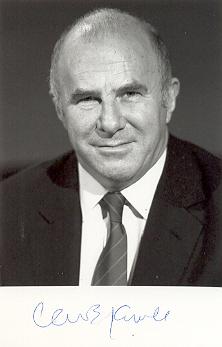
Clive James
Richard Forster (Winterthur, Switzerland) writes:
‘When did the Swiss System obtain its name and when was it invented? The standard reference works mention that it was introduced by Dr Julius Müller of Brugg at the 1895 Swiss Championship in Zurich.
Julius Müller (1857-1917) was a meteorologist and teacher in Brugg (not far from Zurich). He was a founding member of the Swiss Chess Federation in 1889, and a member of the committee and then treasurer until 1903, when he was elected an honorary member. The Swiss pairing system, the official magazine (Schweizerische Schachzeitung) and many other sparkling ideas are credited to him (as noted in his obituary in the Schweizerische Schachzeitung, July 1917, page 103).
The Swiss system was created for the Swiss chess congresses which, starting in 1889 in Zurich, usually packed four or five rounds into two or three days (plus a problem-solving contest, a general assembly and a banquet). As is shown by the tournament regulations (Turnier-Ordnung), during the first few years a prototype of the modern system was used: after each round the field was, according to the results of the previous round, divided into two groups, winners and losers, who were then paired among each other by lot. In case of a draw it was decided by lot who would belong to the “winners” and who to the “losers”. Only at the very end were the points gained added together to ascertain the final ranking. Whether or not attention was paid to equal colour distribution is unknown, and we do not know for sure whether the same two players could be paired against each other more than just once. In the third edition, for instance, two players won with 4/4 in a field of 16; this would not be possible under today’s system because they would have met in the fourth round at the latest.
For the ninth congress (Lausanne, 1899) the rules were changed so that players with an equal number of points were paired against each other, but in case of a draw one player was still counted as the “winner” and the other as the “loser”. Only in the rules for the St Gallen congress (1901) was it stated that the actual number of points was the sole criterion for pairing.
This does not exclude the possibility that the pairings were handled in the modern way long before the St Gallen tournament (after all, the members of the pairing committee were presumably always the same), but it still leaves open the question of why the 1895 tournament is commonly singled out as marking the birth of the Swiss System.
Incidentally, in 1940 Erwin Voellmy referred to Julius Müller as the inventor of the “Swiss (or sometimes Danish) pairing system” (Schweizerische Schachzeitung, May 1940, page 71). What is known about these Danish roots of the Swiss System?’
Unusual photographs are always welcome, and below is a shot of Edouard (not ‘Eduard’) Pape from page 163 of the September-October 1921 American Chess Bulletin:
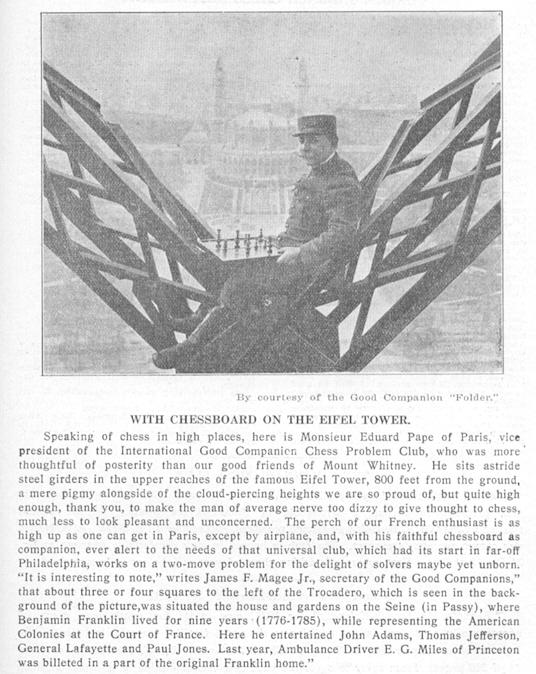
C.N. 52 gave the following piece of play and asked if the full game-score was available. Nothing more has been found.
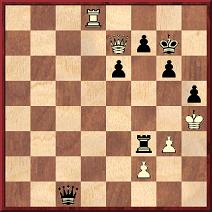
‘Lazdies v Zenitas, Riga, 1936’
White is said to have played 1 Qf8+ Kf6 2 Qh8+ Kf5 3 g4+ hxg4 4 Rd5+ exd5 5 Qc8+ Drawn.
We took the position from page 64 of The Pleasures of Chess
by Assiac (New York, 1952), but another secondary source, page
268 of Kurzgeschichten um Schachfiguren by Kurt Richter
(Hollfeld, 1991), gives the players’ names as Lazdiņš and
Zemītis and the date as 1935.
Calle Erlandsson (Lund, Sweden) sends four photographs of the Euwe memorial which were taken by him on 27 November 2004:
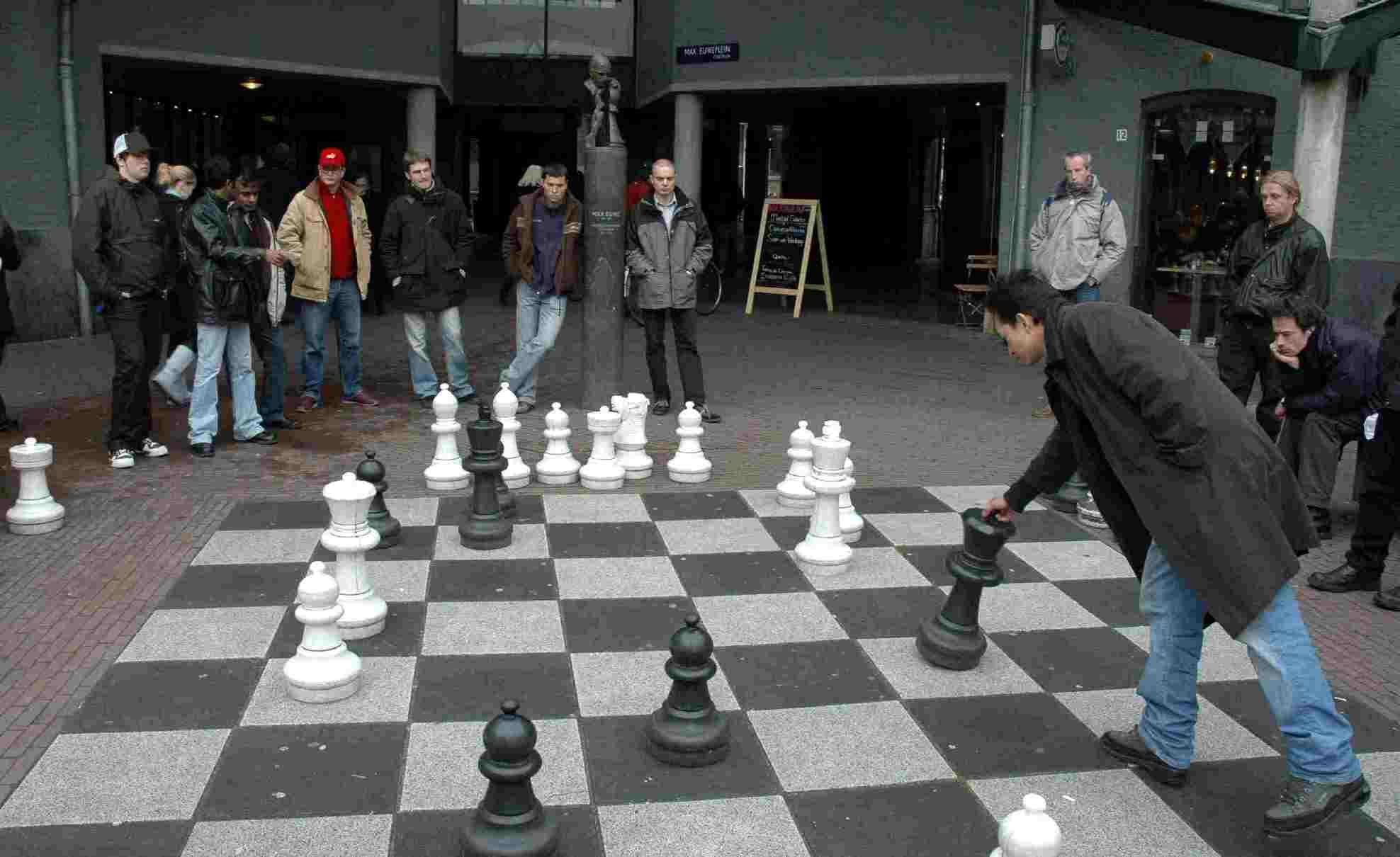
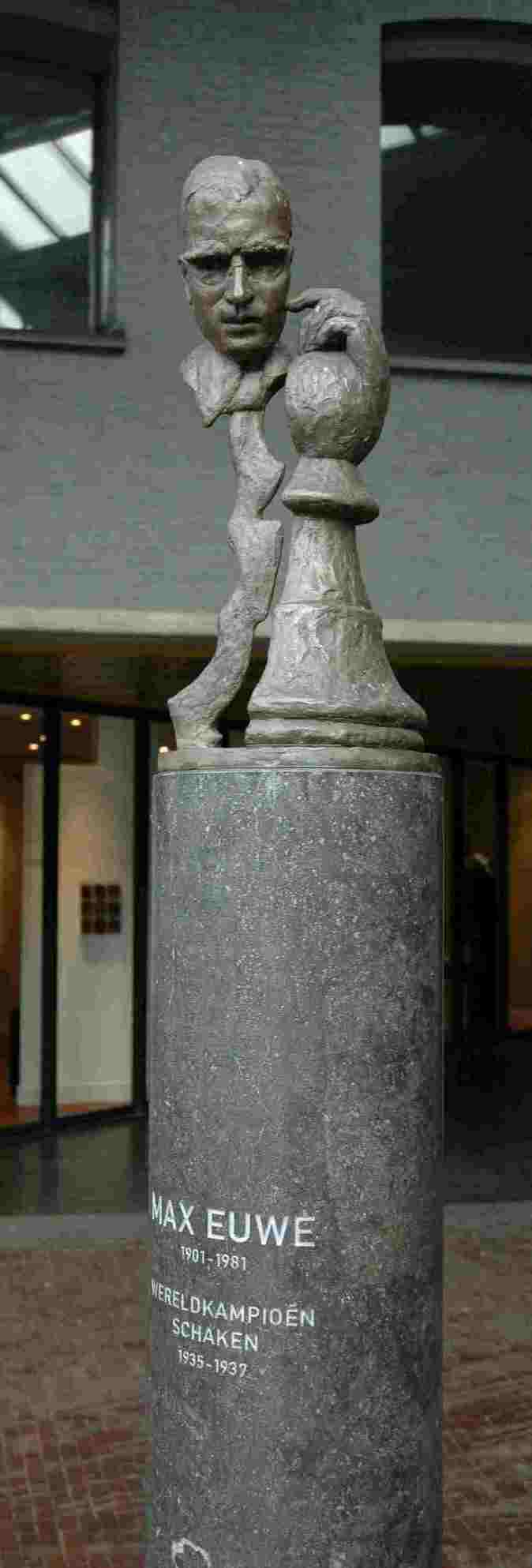
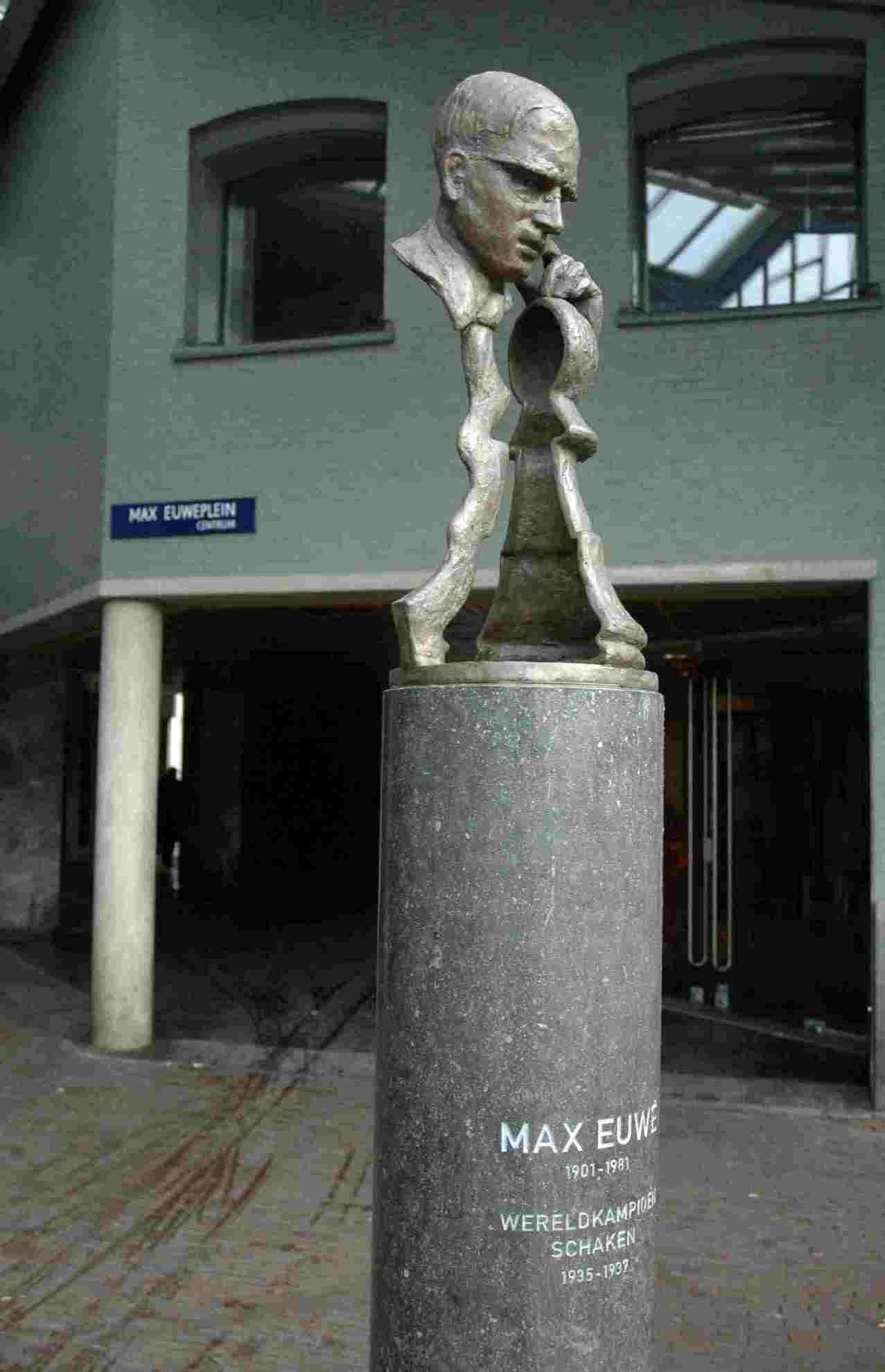
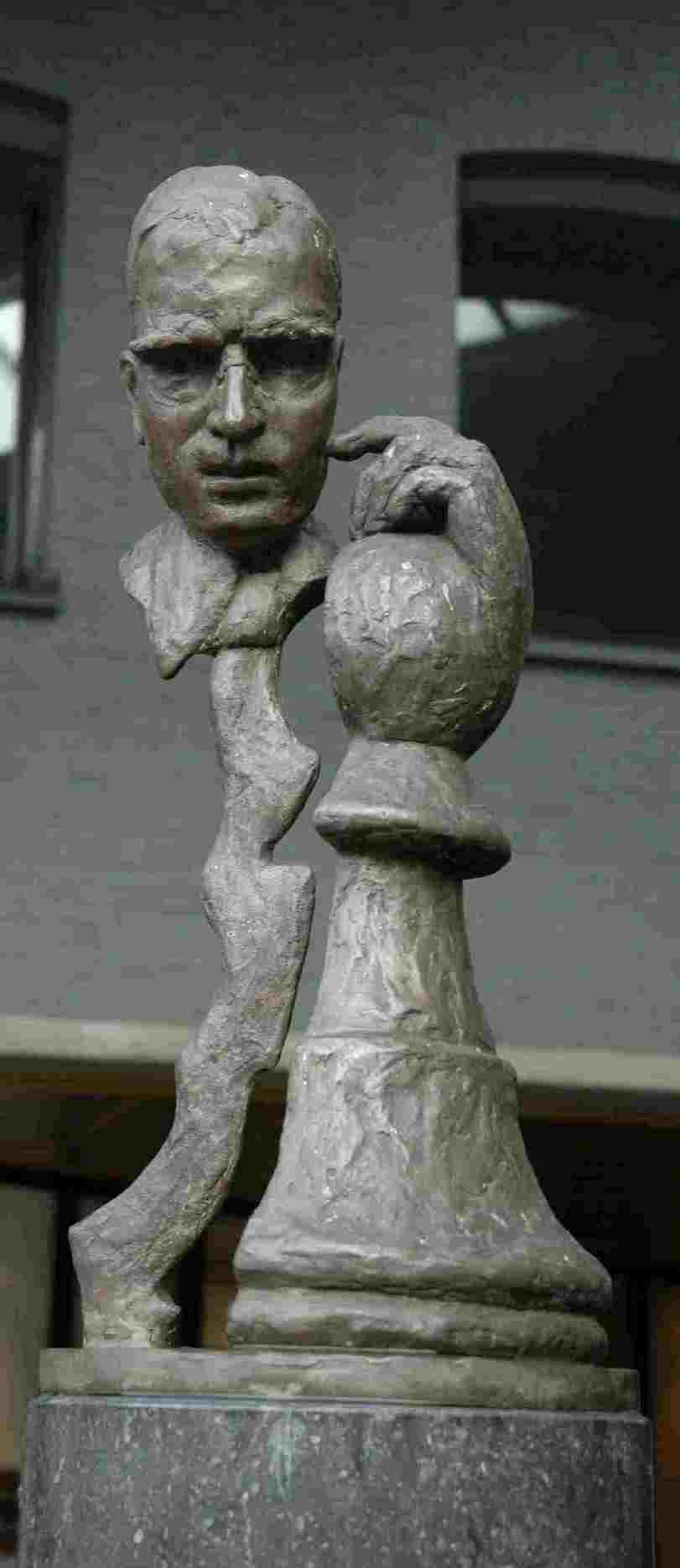
The group photograph in C.N. 4046 was taken at the Margate Congress of 1923 and appeared opposite page 153 of the May 1923 BCM with the caption as below:
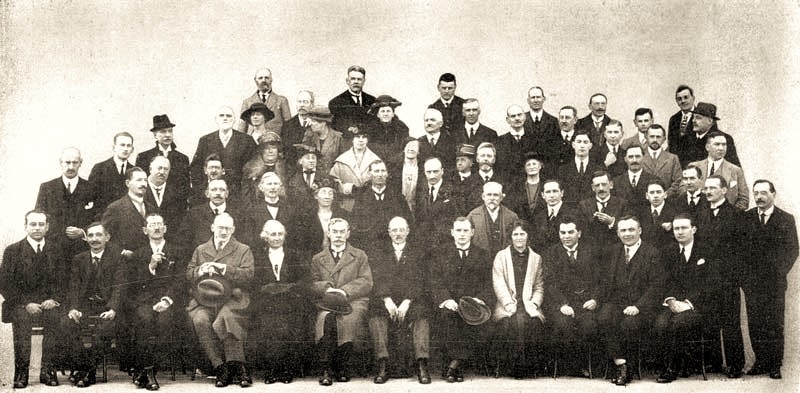
Front row (left to right): J. du
Mont, O.C. Müller, E.E. Colman, E. Grünfeld, Mrs Holloway, R.P.
Michell, S.J. Holloway, A. Alekhine, Mrs Stevenson, R. Réti,
E.D. Bogoljubow, A. Muffang
Second row: H.J. Snowden, F.V. Louis, E.B. Puckridge, A.
Thompson, Mrs Thompson, H.J. Salter, M. Romih, F.M. Argrave, Dr
Mendes, Dr. G.C.A. Oskam, E. Colle, P.W. Sergeant, O.
Zimmermann, H.J.H. Cope
Third row: J. Hartong, F. Brown (hat on), J. Whicker (white
scarf), C.H. Taylor, Miss Andrews, Miss L. Eveling, Mrs Fish,
Mrs Fraser, Miss Abraham, G.M. Arrowsmith, Miss Eveling, T.G.
Griggs, P. Sullivan, G. Key
Fourth row: J. Keeble, Miss Green, A.S. Fish, Mrs Michell, Mrs
Seale, J.E. Coleman, A.D. Barlow, S.P. Lees, L.C.G. Dewing, R.M.
Norman, Commander Graham, Hon. F.G. Hamilton-Russell (hat on)
Back row: F.W. Schneider, E.S. Tinsley, A.H. Reeve, E.J. Price,
F.A. Richardson, Capt. P.D. Bolland
Although by no means unknown, the game below is notable for a curious march by the black king, which advances as far as f4 and e4 but is back on its home square at the moment of victory:
G. Bezručko – Efim Bogoljubow
Kemeri-Riga, March 1939
Sicilian Defence
1 e4 c5 2 d4 cxd4 3 Qxd4 Nc6 4 Qe3 Nf6 5 Nc3 g6 6 Be2 d6 7 f4 Bg7 8 Nf3 Ng4 9 Qg1 f5 10 h3 Nf6 11 exf5 Bxf5 12 Nd4 O-O 13 Nxf5 gxf5 14 Be3 d5 15 O-O-O e6 16 g4 Ne4 17 gxf5 Nxc3 18 bxc3 Qa5 19 fxe6 d4 20 Rxd4 Kh8 21 Bc4 Qa3+ 22 Kd2 Na5
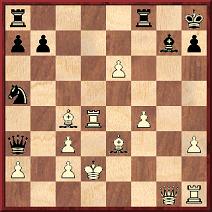
23 Qxg7+ Kxg7 24 Rd7+ Kf6 25 Bd4+ Kf5 26 Rd5+ Kxf4 27 Be3+ Ke4
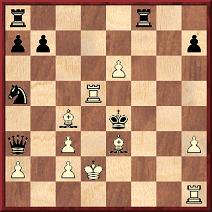
28 Rd4+ Ke5 29 Rd5+ Kf6 30 Bd4+ Ke7 31 Rd7+ Ke8 32 Bb5 a6 33 Rxb7+ axb5 34 White resigns.
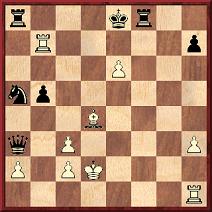
Source: Šachs Latvijā by K. Bētiņš, A. Kalniņš and V. Petrovs (Riga, 1940), pages 265-266. The game also appeared, with detailed (languageless) notes, on pages 229-230 of Bogoljubow – The Fate of a Chess Player by S. Soloviov (Sofia, 2004).
Below is Bogoljubow’s inscription in one of our copies of his 1935 book Schach-Schule:
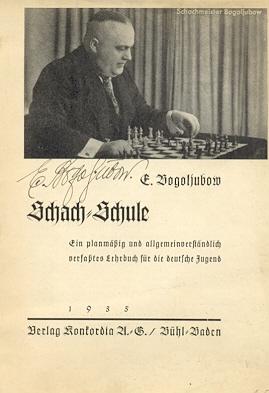
The preceding item reminds us that when Réti died a Vienna newspaper, Der Abend of 6 June 1929, mixed him up with Bogoljubow:
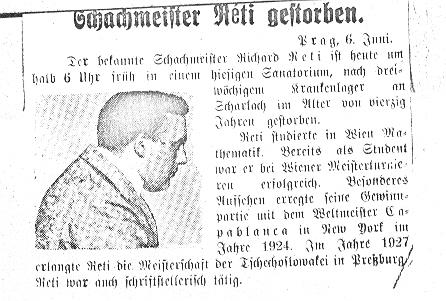
C.N. 3510 presented 13 sketches and caricatures of Richard Réti in our collection. Now we have found three more:
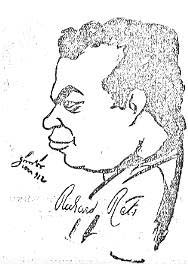
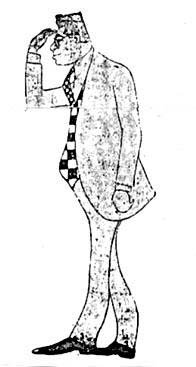
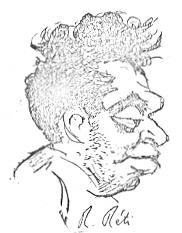
From page 345 of The Personality of Chess by I.A. Horowitz and P.L. Rothenberg (New York, 1963):
‘That a richly endowed robot will one day be able to play a highly skillful game of chess leaves no room for doubt. On the other hand, in the absence of a fantastic superspeed electronic brain, the chess championship of the world is likely to be retained by humans for centuries to come.’

The task was to exchange the positions of the pieces without any attacks on pieces of the opposite colour. D.J. Morgan gave the solution as follows on page 45 of the January 1973 BCM: 1 Nc3 Nd7 2 Na2 Nc5 3 Nb4 Ne7 4 Nf3 Nf5 5 Ba3 Bh6 6 Nh2 Ne4 7 Nc6 Bd2 8 Ng4 Nc3 9 Bh3 Ba6 10 Bf8 Ng3 11 Nf6 Bc1 12 Bd7 Bf1 13 Bc8 Nge2 14 Nb8 Nb1 15 Ng8 Ng1.
He commented:
‘It will be found that the knights alone on the board require ten moves on each side to change places. (A king’s knight cannot change places with a queen’s knight in four moves without attacking one another.) The bishops, similarly taken alone, need six moves on each side. But, working them together, it is possible to save a move on each side with the bishops by the stratagem, as shown, of screening them with two knights and so enabling one bishop of each colour to make its journey in only two moves, and its opponent in three moves.’
Page 75 of Rudolf Spielmann Portrait des Schachmeisters in Texten und Partien by M. Ehn (Koblenz, 1996) has a photograph of Spielmann’s grave in Stockholm.
There seem to be few photographs of Spielmann taken during his last years. Offhand, the latest we recall seeing is on page 54 of Mina Bästa Partier by Harald Malmgren (Örebro, 1953). It shows Spielmann facing Malmgren in a simultaneous exhibition:
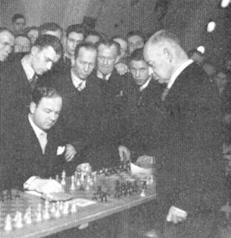
Yakov Zusmanovich (Pleasanton, CA, USA) draws attention to the front cover of Életem, a sakk by A. Lilienthal (Budapest, 1985):
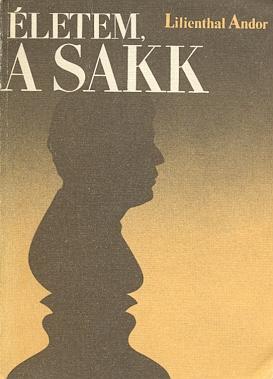
A particularly rare finish occurs when a checking move is answered by instant mate. Over the years we have come across very few specimens, the first (E. Bogoljubow v A.H. Trott, Southsea, 1950) having been given in C.N. 151:
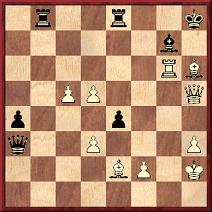
39...Be5+ 40 Bf4 mate.
Source: Rising Stars by W.H. Pratten (Southsea tournament book), pages 48-49.
The next position comes from a game presented in C.N. 648 (see page 42 of Chess Explorations):
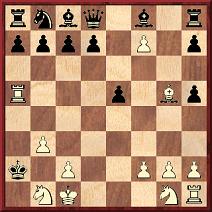
E. Böök – A. Hiidenheimo, Helsinki, 1924. The game ended 15...Ba3+ 16 Rxa3 mate.
Source: Odödliga partier och andra schackkåserier by
E.Böök (Halmstad, 1966), pages 36-37.
The third case arose in a game headed only ‘N.N. – van Foreest, Amsterdam’ when published on page 157 of the 15 July 1887 Brooklyn Chess Chronicle:
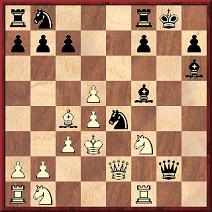
18 Qxg2+ Ng3 mate.
For the complete game see pages 77-78 of Kings, Commoners and Knaves.
The following position, concerning an 1874 game in Dorpat, may or may not have occurred over the board. For further information see pages 14-15 of Chess Facts and Fables.
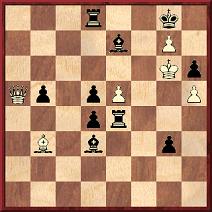
1 exd6+ Re6 mate.
The final example has been found in Megabase 2005 (B. Templier v T. Liard, Montigny le Bretonneux, 2003):
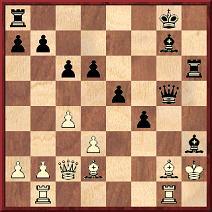
27 Bd5+ Be6 mate.
We hope that readers are keeping abreast of the feature articles which have been posted. There are now 38 in all.
From Miriam Friedman Morris (Pomona, NY, USA):
‘C.N. 3510 includes three portraits of Réti (1, 9 and 11) produced by my father, David Friedmann (1893-1980).
Richard Réti (Copyright: Miriam Friedman Morris)
He is renowned for a series of lithographs entitled “Das Schachmeister Turnier in Mährisch-Ostrau, Juli 1923” (The Chess Master Tourney) and “Köpfe berühmter Schachmeister” (Portraits of Famous Chess Masters). Four portfolios of “Köpfe berühmter Schachmeister” were found. One of them, No. 28, is in the collection of the Royal Library of the Netherlands, The Hague.
The portfolio of the Mährisch-Ostrau tourney comprises 14 lithographs, one portrait representing each participant: Lasker, Réti, Grünfeld, Selesniev, Euwe, Tartakower, Bogoljubow, Tarrasch, Spielmann, Rubinstein, Pokorný, Hromádka, Wolf and Walter.
The portfolio “Köpfe berühmter Schachmeister” consists of 12 or 14 portraits. Two chessplayers were dropped, whereas Ossip Bernstein and/or Richard Teichmann were added. It is possible that as many as 50 portfolios were produced. All the lithographs bear the signature of the chessplayer depicted, and the signature Dav. Friedmann was handwritten in pencil on each lithograph.
He specialized in portraits drawn from life of famous personalities from the arts, music, theater, sport, politics, etc. His pre-War art was confiscated by the Gestapo in Berlin and in Prague under the auspices of the German Reich. In search of evidence of his career, I have discovered over 100 portraits published in the B.Z. am Mittag, among them Capablanca, Alekhine, Vidmar and Nimzowitsch. There are probably other portraits of chessplayers still unaccounted for, and it would be fascinating to discover who they are and where the remaining portfolios are located.
David Friedmann survived the Holocaust, but his wife and daughter perished. His post-War journey took him from Czechoslovakia to Israel and to the United States, where he continued to paint until he died in 1980, in St Louis.
I shall be grateful for any help in creating an inventory of his lost works and preserving the legacy of a remarkable artist.’
Our correspondent has also kindly provided a rare photograph of her father, taken in Berlin on 15 September 1924:
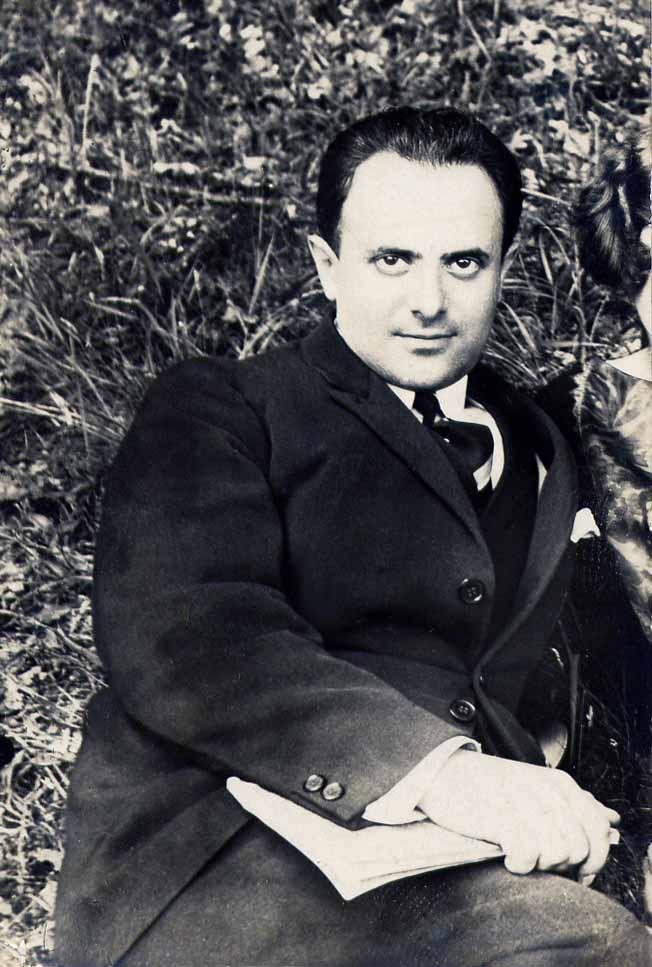
David Friedmann
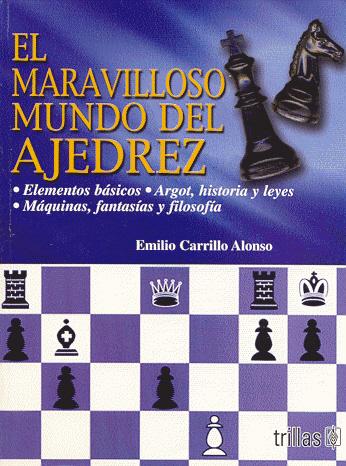
Owing to a printing fault in our copy of El maravilloso mundo del ajedrez by Emilio Carrillo Alonso (Mexico City, 2002) quite a few pages are blank. It is a pity that those which are not are not. Pages 157-160, for instance, might profitably have been an ink-free zone, but instead the author annotates games purportedly played by Stalin and Einstein, both of them headed ‘Moscow, 1926’. (See the Factfinder for references to these two matters.)
On page 67 he unhelpfully and without further particulars attributes the ‘pity’ quote (C.N. 3949) to ‘León Tolstoi (1883-1945)’, although those are the dates of Alexei Tolstoy. Page 77 could readily have gone too. Without corroboration it ascribes to Rubinstein the remark about learning from Anderssen how to make combinations and from Tarrasch how to avoid making them. (That quote is commonly attributed to Spielmann, but what is the exact original source?) On the same page Alonso shows himself a disciple of the ‘once’ school of anecdotage, the equally casual Spanish equivalent of ‘once’ being ‘en alguna ocasión’. Thus we learn that Marshall ‘once’ said of Capablanca, ‘Anyone who has beaten me in a contest is inevitably a great player.’ (‘En alguna ocasión afirmó de Capablanca: “Quien me ha ganado a mí en un encuentro es por fuerza un gran jugador”.’
C.N. 3574 asked which Mendelssohn declared that ‘chess is too much of a game to be a science and too much of a science to be a game’. That open question is complicated further on page 66, where Alonso claims that the remark was made, ‘en alguna ocasión’, by Gottfried Leibniz:
‘G.W. Leibniz (1646-1719), filósofo y matemático alemán, dijo en alguna ocasión: “El ajedrez es demasiado juego para ser una ciencia y demasiada ciencia para ser un juego”.’
Alonso is three years out with Leibniz’s year of death, but is he necessarily wrong about the rest? After all, can anyone hope to prove decisively whether or not such a ‘once’ quote is correct? The same may apply to an observation sourcelessly attributed to Salo Landau on page 76: ‘El ajedrez es como una droga: beneficioso en pequeñas dosis, fatal en dosis frecuentes.’ (Chess is like a drug: beneficial in small doses, fatal in frequent doses.’)
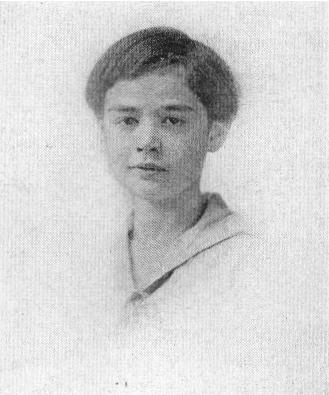
Who is this chess prodigy?
Christian Sánchez (Rosario, Argentina) adds the following:
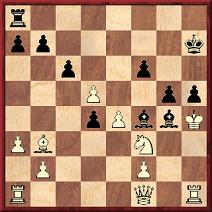
Reina – Thimm, Mexico City, circa 1884.
27 Nxg5+ fxg5 mate.
See pages 137-138 of the Brooklyn Chess Chronicle, 15 June 1884 and pages 118-119 of Kings, Commoners and Knaves.
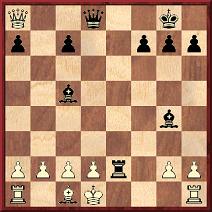
Amateur – Winkelman, Philadelphia, 1945.
14 Qxd8+ Re8 mate.
The full game was given on page 99 of 1000 Best Short Games of Chess by I. Chernev (New York, 1955), and further details will be welcomed.
From David Picken (Greasby, England):
‘On the dust cover of the tenth edition of Modern Chess Openings (London, 1965) authored by Walter Korn and Larry Evans but mainly by the latter there is a silhouette of a chessplayer studying a board. He is not identified but does, in my view at least, resemble Evans.’
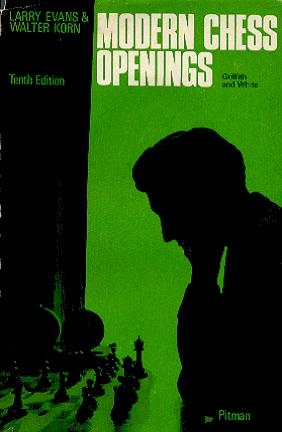
C.N. 3890 gave a seldom-seen picture of Paul Morphy. Here is another one, from page 182 of “Our Folder” (the Good Companion Chess Problem Club), 1 May 1921:
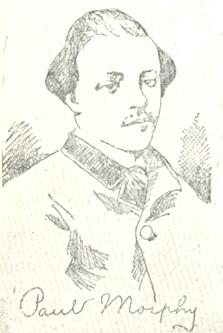
C.N. 2249 (see page 20 of A Chess Omnibus) dealt with the conclusion of a game between Celso Golmayo and Emilio Hidalgo, Havana, 1885, as discussed in that year’s Brooklyn Chess Chronicle and International Chess Magazine. It may be added here that the two periodicals’ follow-up material (listed in our earlier item) was overlooked when the March 1908 Lasker’s Chess Magazine, page 227, published a full-page feature criticizing the 1885 analysis.
An addition to the list in C.N. 3529 is Chesspearean. From page 40 of The Personality of Chess by I.A. Horowitz and P.L. Rothenberg (New York, 1963):
‘The brutal plot of this Chesspearean tragedy culminates in banishment of the lady.’
When was the term ‘hypermodern chess’ first used? The earliest citation we can offer at present is in the booklet Am Baum der Schacherkenntnis by S. Tartakower (Berlin, 1921). Pages 15-16 have an article entitled ‘Das hypermoderne Schach’.
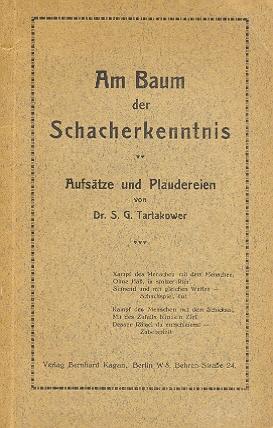
‘Man of many parts and distinguished in them all’ was D.J.
Morgan’s description of Lord Dunsany in the obituary published on
page 311 of the December 1957 BCM, which also remarked:
‘As a man of action he had been soldier, sportsman, traveller and big game hunter. In the literary world he won fame as poet, essayist, story-teller and playwright.’
C.N. 169 gave the following game (played in a 21-board simultaneous display) from the Times Literary Supplement of 25 April 1929, page 343:
José Raúl Capablanca – Lord Dunsany1 e4 e5 2 Nf3 Nc6 3 Bb5 a6 4 Ba4 b5 5 Bb3 Nf6 6 Ng5 d5 7 exd5 Ne7
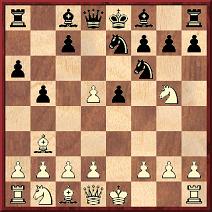
8 d6 Ned5 9 dxc7 Qxc7 10 Nc3 Bb7 11 a4 b4 12 Nxd5 Bxd5 13 Bxd5 Nxd5 14 O-O Be7 15 d4 O-O 16 dxe5 Qxe5 17 Re1 Qd6 18 Ne4 Qc6 19 Bg5 Bxg5 20 Nxg5 Rac8 21 Qf3 Nf6 22 Re2 h6 23 Qxc6 Rxc6 24 Nf3 a5 25 Nd4 Rc5 26 Nb3 Rd5 27 Rae1 Nd7 28 Re4 Nb6 29 Re5 Rfd8 30 Rxd5 Rxd5 31 Kf1 Nxa4 Drawn.
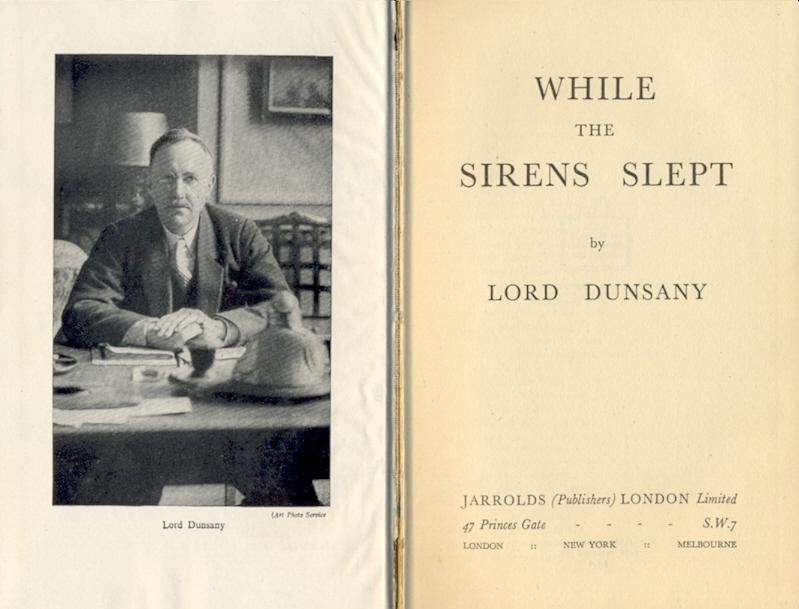
Lord Dunsany wrote an account of the contest on pages 112-113 of his autobiography While the Sirens Slept (London, circa 1945):
‘Early that same spring [1929] Capablanca, perhaps the greatest chessplayer the world has ever known, and at that time Champion of the World [sic], came to London and gave a display at Selfridge’s. He played simultaneous chess against three representatives from each of the seven counties that are nearest to London, which means roughly the seven strongest counties in England, and Mr Selfridge offered a prize to whatever county did best against him. I was asked to be one of the players from Kent. We sat at a row of tables in a long room with a large crowd leaning over us, and Señor Capablanca walked along the row. I was rather anxious that it should not be thought that I had been chosen to play merely because I was president of the Kent Chess Association, and the only way of showing that was to hold out for at least half an hour. I have mentioned earlier my ignorance of the openings, and Capablanca, who of course had first move on every board, chose the opening that probably corresponds with whatever is the most complicated theory in any science, that is to say the Ruy López. I made for my fourth move one that should have come later, not realizing how much it mattered. Of this simple blunder Capablanca naturally took immediate advantage, and I looked very unlikely to hold out for half an hour. But then I began to play, and by sacrificing a pawn got out of the muddle into which I had strayed, though playing with a pawn down against Capablanca did not seem a very hopeful proposition. Curiously enough my blunder saved me, for in the complications of an ordinary Ruy López as played by Capablanca I should no doubt have been easily beaten; but the clock went on and I was still playing, and at last I got the pawn back, and at the end of four hours when play ended, I had an obvious draw, and Capablanca conceded rather reluctantly a draw to my neighbour on my left, so that Kent had scored one point against him, a draw being half; and a player from Hertfordshire had won his game, and, these two counties being equal, the man who had won and we two who had drawn were all given a prize by Selfridges. For Capablanca had beaten all the rest [sic – two other players drew]. As the prize was handed to me the representative of the firm who gave it said, “And if there is anything you would prefer, do let us know”. The prize was wrapped up in a box, and I said I was sure that there would not be anything that I should prefer to it. But when I got home and opened the box, I found that the prize was a cocktail-shaker; a very handsome one, but still to a chessplayer as useless as reindeer-harness to anyone in a Southern country. So in spite of what I had said, I wrote asking if, with the exception that I have mentioned, I could be given anything else, and I was kindly given, duly inscribed, the largest and most useful thermos flask that I have ever had, and after nearly 15 years it is as good as ever. My game with Capablanca was recorded in The Times, in the Chess Column, that year.’
Lord Dunsany had also played against Capablanca in a simultaneous display at the Imperial Chess Club in London on 22 November 1928. He lost. Source (report only): The Tablet, 15 December 1928.
Extensive chess-related extracts from While the Sirens Slept were published in CHESS, January 1946, pages 82-83 and 85. A few passages were also given in Chess World, 1 December 1946, pages 251-252.
It may be recalled that after Capablanca died Lord Dunsany published the following epitaph in CHESS, June 1942, page 131:
Now rests a mind as keen,
A vision bright and clear
As any that has been
And who is it lies here?One that, erstwhile, no less
Than Hindenburg could plan,
But played his game of chess
And did no harm to man.
The harmlessness of chess was a theme taken up again by Lord Dunsany the following year in what is perhaps the finest chess poem ever written in English. It marked the death of R.H.S. Stevenson and was published on page 74 of the April 1943 BCM:
One art they say is of no use;
The mellow evenings spent at chess,
The thrill, the triumph, and the truce
To every care, are valueless.And yet, if all whose hopes were set
On harming man played chess instead,
We should have cities standing yet
Which now are dust upon the dead.
Other chess poems by Lord Dunsany were ‘Where is it?’ (CHESS, June 1943, page 140) and a composition (first line: ‘Silence. And silence still’) which he recited when opening the Hastings, 1950-51 congress. That latter poem was published on page 33 of the February 1951 BCM, page 6 of the January-February 1951 American Chess Bulletin and page 127 of The Treasury of Chess Lore by Fred Reinfeld (New York, 1951).
Below is a photograph taken in Hastings on 28 December 1950. Lord Dunsany (standing on the right) is watching the first-round game between Alan Phillips and Weaver Adams.
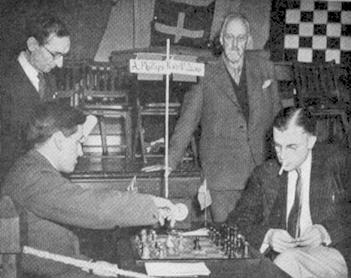
His famous short story ‘The Three Sailors’ Gambit’ can be found on pages 83-85 of CHESS, March 1942, pages 185-192 of Chess Pieces by Norman Knight (London, 1949), pages 204-215 of The Chess Reader by Jerome Salzmann (New York, 1949), pages 65-71 of The Chess Companion by Irving Chernev (New York, 1968), pages 310-317 of Chess in Literature by Marcello Truzzi (New York, 1974) and pages 33-40 of Sinister Gambits by Richard Peyton (London, 1991). We believe that it first appeared in book form in Lord Dunsany’s The Last Book of Wonder (Boston, 1916). A less familiar short story, ‘The New Master’, was published in his book The Little Tales of Smethers and other stories (London, 1952).
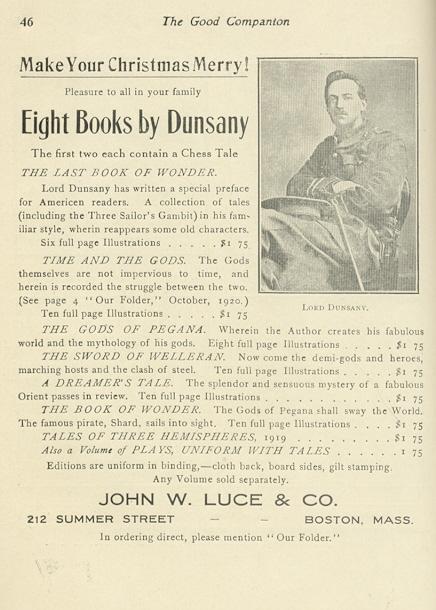
“Our Folder” (the Good
Companion Chess Problem Club), 1 November 1920
Pages 3-5 of “Our Folder”, 1 October 1920 had an article
entitled ‘Lord Dunsany and the Muse of Chess’ by Samuel W.
Strauss, while the first page of that issue included the
illustration below:
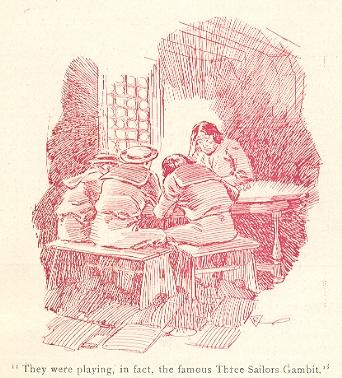
In the realm of problem composition too Lord Dunsany showed much ingenuity. Taken from page 64 of While the Sirens Slept, the following passage discusses his approach to creating problems:
‘And while I am on the subject of chess I may say that now and then during the years of which I have been writing I made a chess problem and used to send them to Mr E. Tinsley, for many years the chess editor of The Times Literary Supplement, whose cheery presence was never absent from any important match in or near London. I followed some principles in these problems which will be readily understood even by those who do not play chess. My first principle was that it should look childishly easy, my next, but still more important, was that an examination of it should make it appear entirely impossible, and then if I could add a little humour to the situation I was content. All puzzles may be approached in this manner. A good many of the problems that I sent to Mr Tinsley and that he reproduced in The Times Literary Supplement were “White to play and mate in one move”, fulfilling the first two conditions that I have mentioned, and that it could be done at all under these conditions perhaps fulfilled the third. The following brief sentence is only for chessplayers: one day I invented a new theme in a castling problem, and how very new it was will be appreciated by chessplayers, though perhaps scarcely believed by them, when I say that it was even new to Mr T.R. Dawson. A couple of years later than the year of which I now tell I collected some of these and (hoping that their published solutions would have been forgotten) offered a prize of half a dozen snipe to any members of the Kentish Chess Association who would solve them, for I have always felt that a president should do a little more to justify himself than merely to ornament notepaper; and I tried to amuse the members of the principal Dublin chess club in the same way. What the builder of the labyrinth in Crete was to men’s feet Mr Hubert Phillips is today to their thoughts, and among his intricacies he has printed six of these problems in his Week-end Problems Book, published in 1932. Mine also was the puzzle in that book about how to build a square house with its walls all facing south; as well as something about Big Ben. My problems appeared there in great company, for they follow one of Sam Loyd’s, the American problemist, who might well be called the leader of all whose avocation was to puzzle mankind, in comparison with whose chess problems and other puzzles, to tell what Hitler is going to do next is merely a childish exercise.’
‘Lord Dunsany’s Inferential Problems’ were given on pages 179-184 of the above-mentioned book by Hubert Phillips. The first of them was:
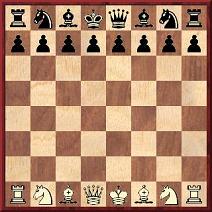
White to play and mate in four.
A later composition by Lord Dunsany, woven into a brief story, was ‘Jorkens’ Problem’, on page 81 of CHESS, January 1949, with corrections by readers (including Lord Dunsany himself) on page 110 of the February 1949 issue. In the early 1940s he invented ‘Dunsany’s game’, wherein the white army consisted exclusively of pawns, filling the first four ranks. See page 97 of The Encyclopedia of Chess Variants by David Pritchard (Godalming, 1994).
Lord Dunsany maintained his interest in chess until the end. Page 24 of CHESS, 19 October 1957 acknowledged a contribution from him on an analytical point, and the following issue (page 37) reported that he had died in Dublin on 25 October, at the age of 79.
| First column | << previous | Archives [18] | next >> | Current column |
Copyright 2006 Edward Winter. All rights reserved.